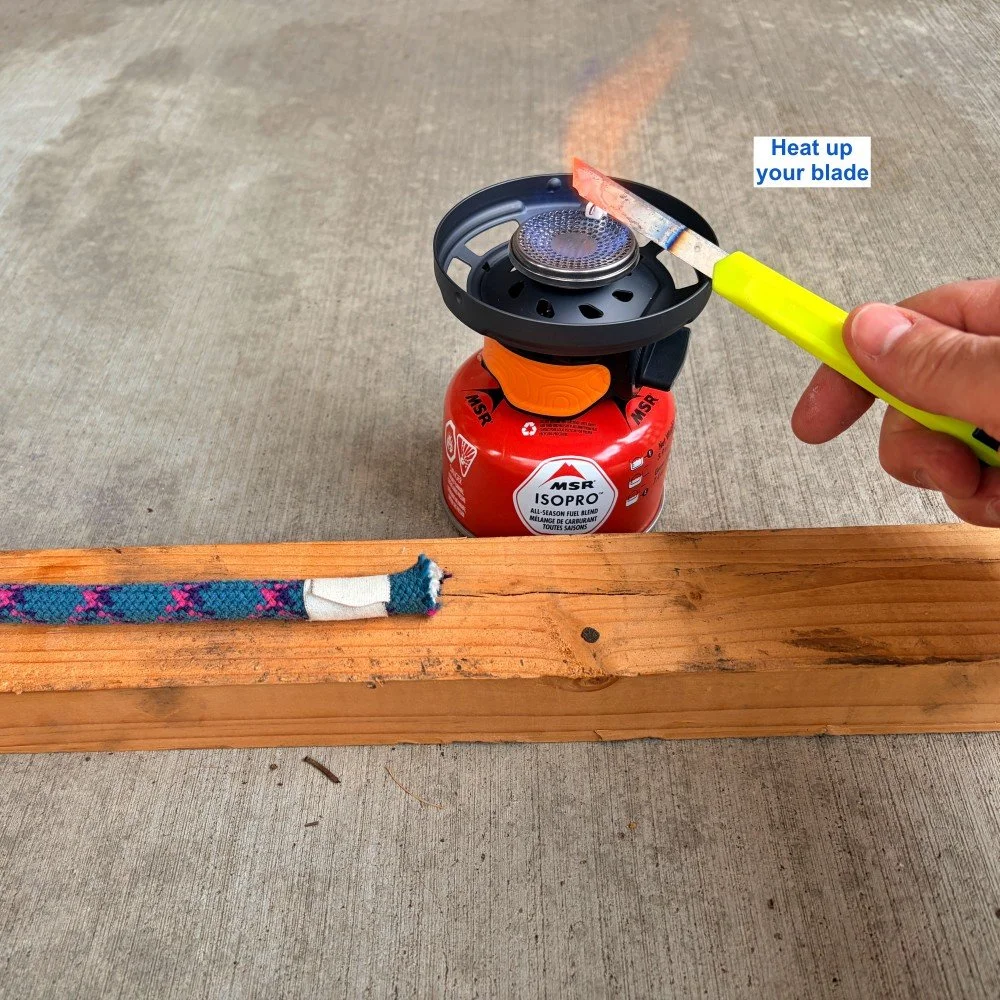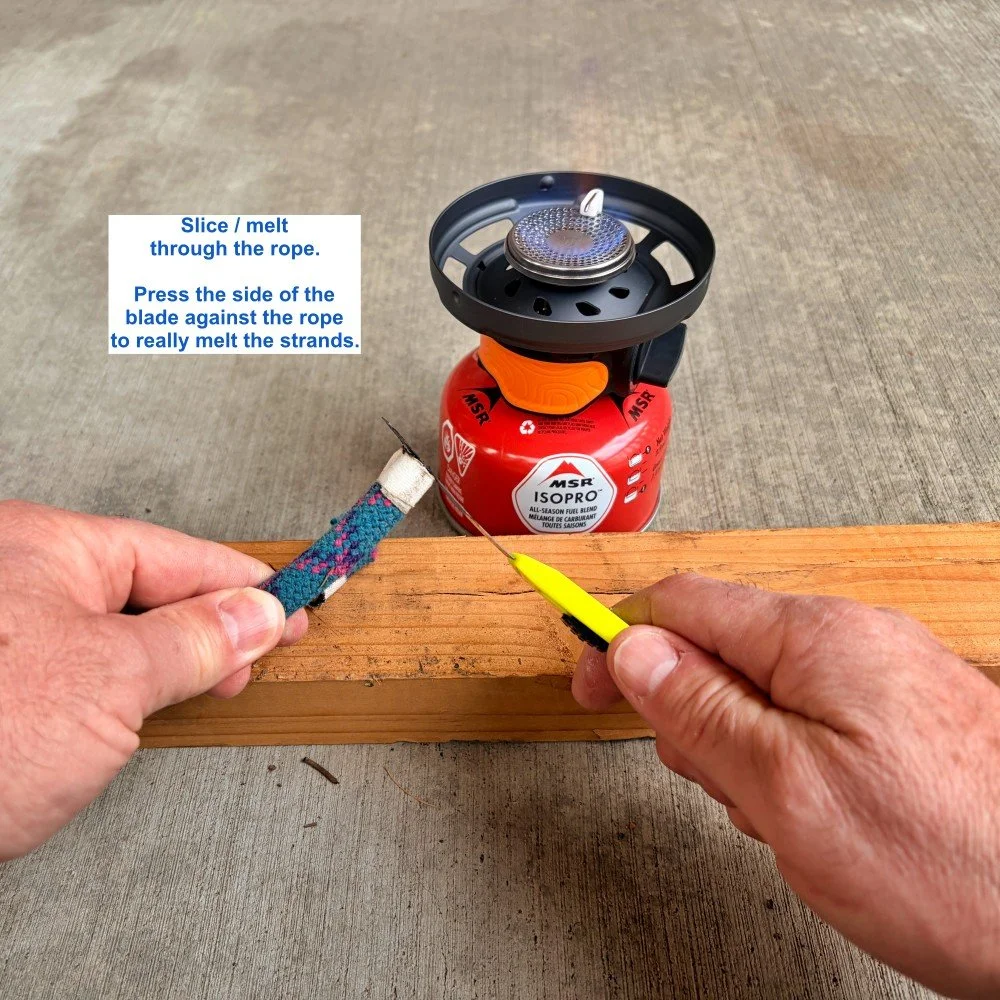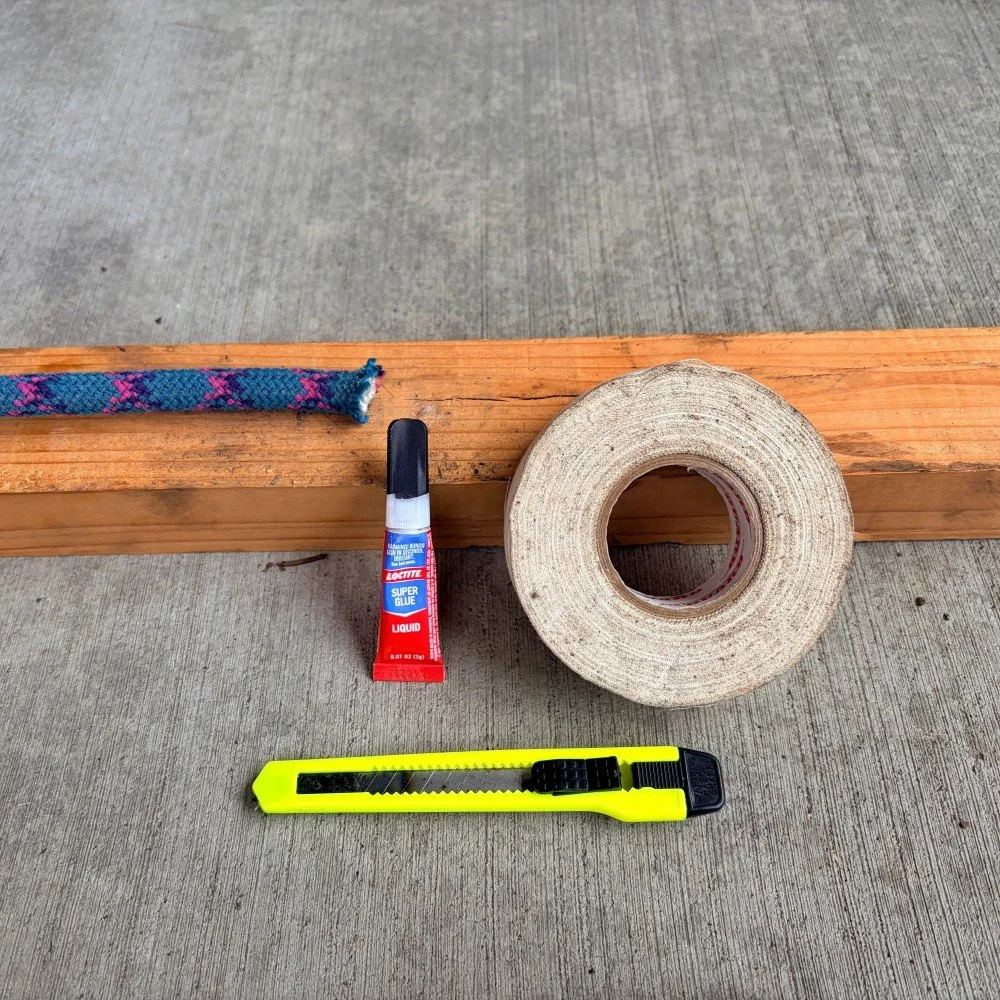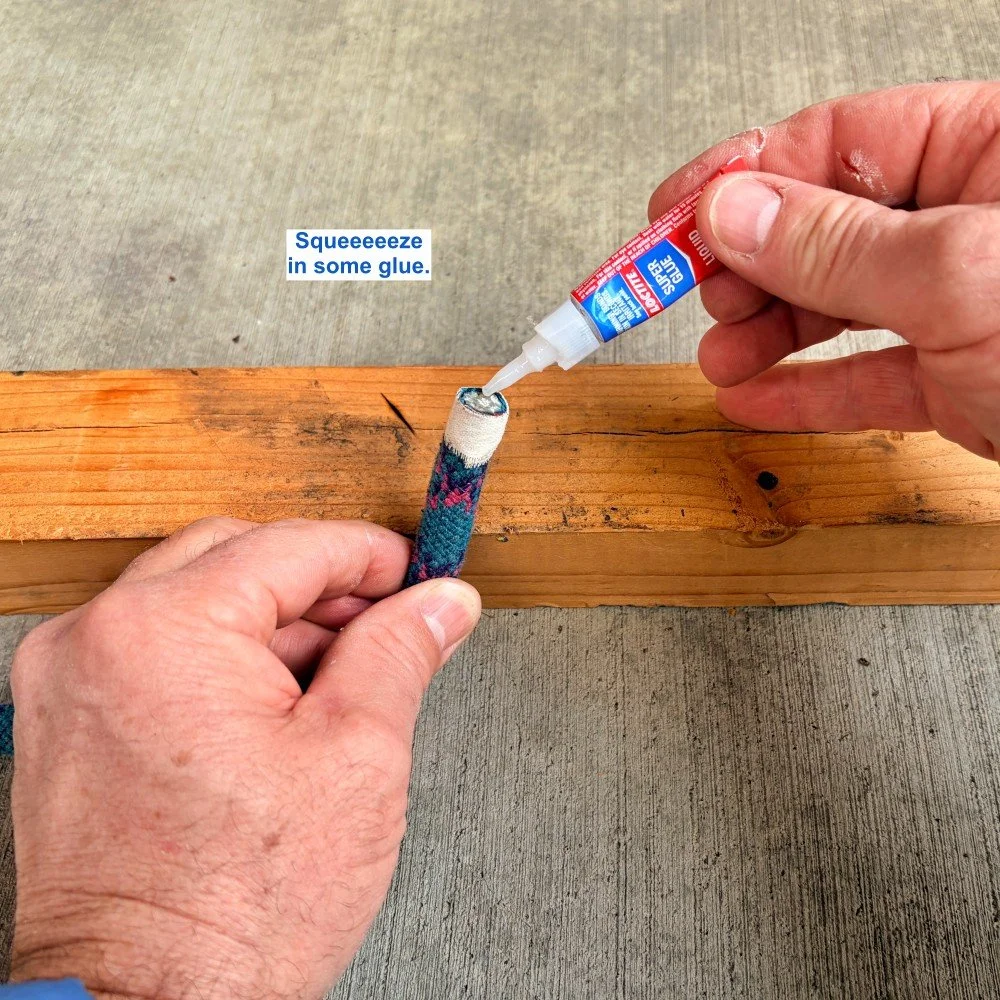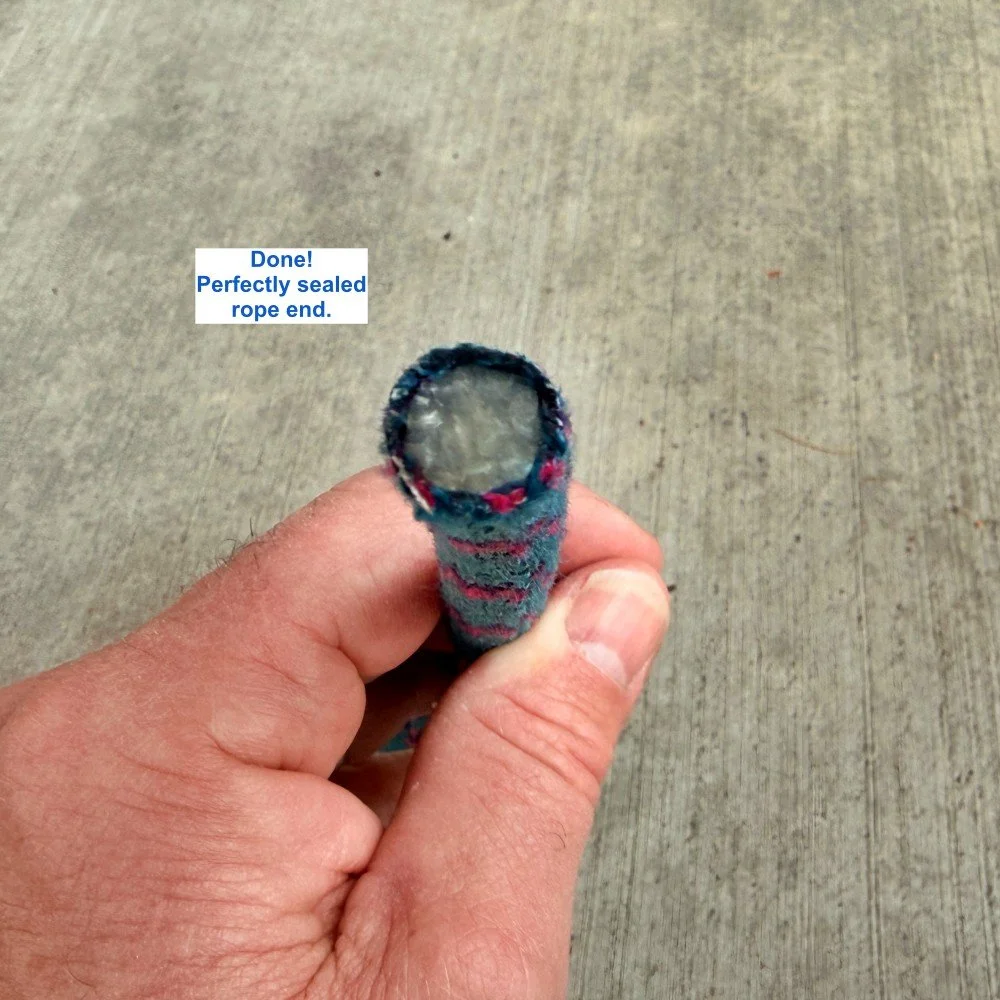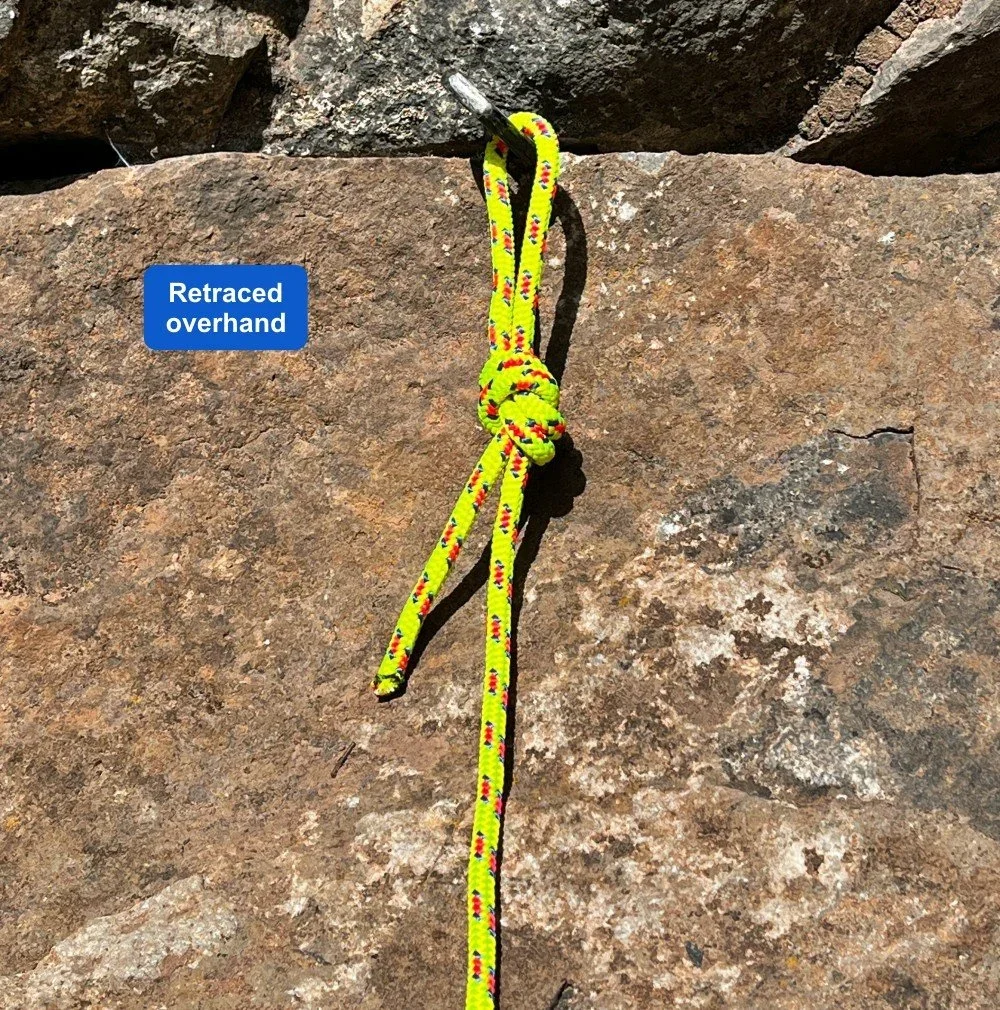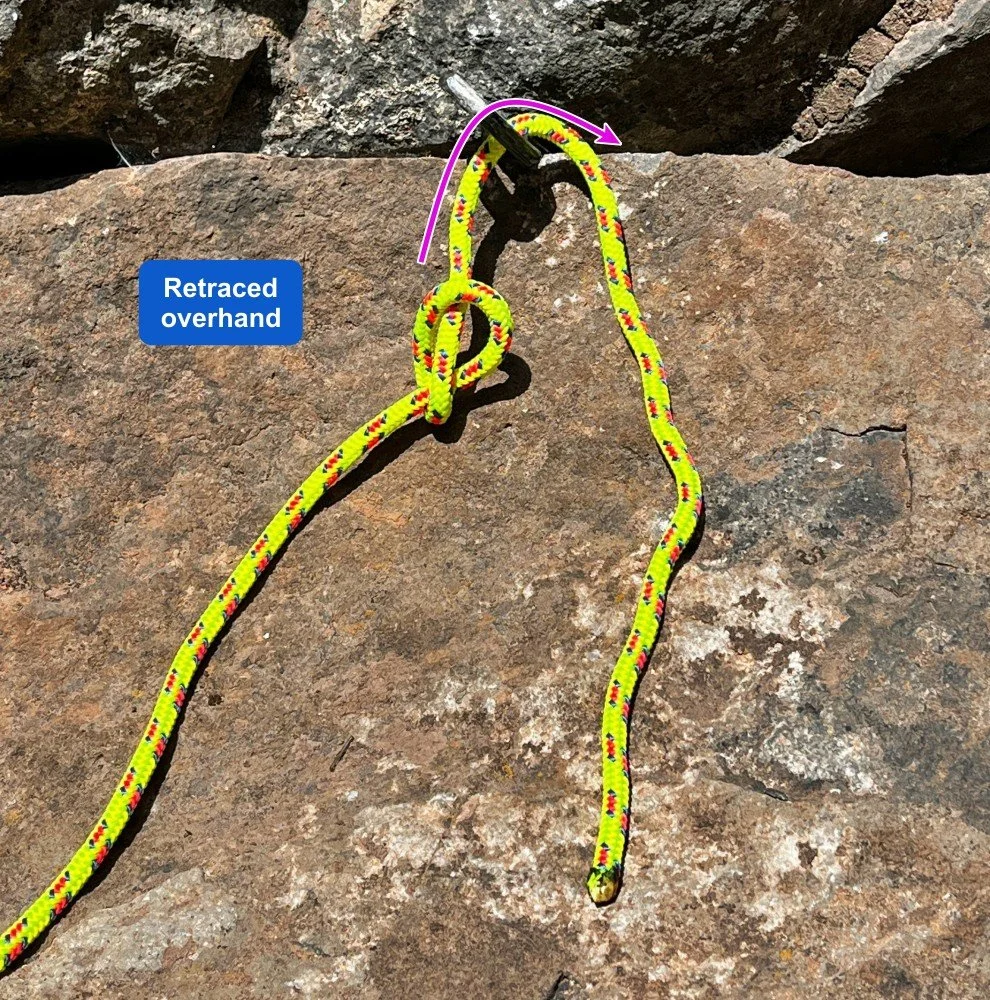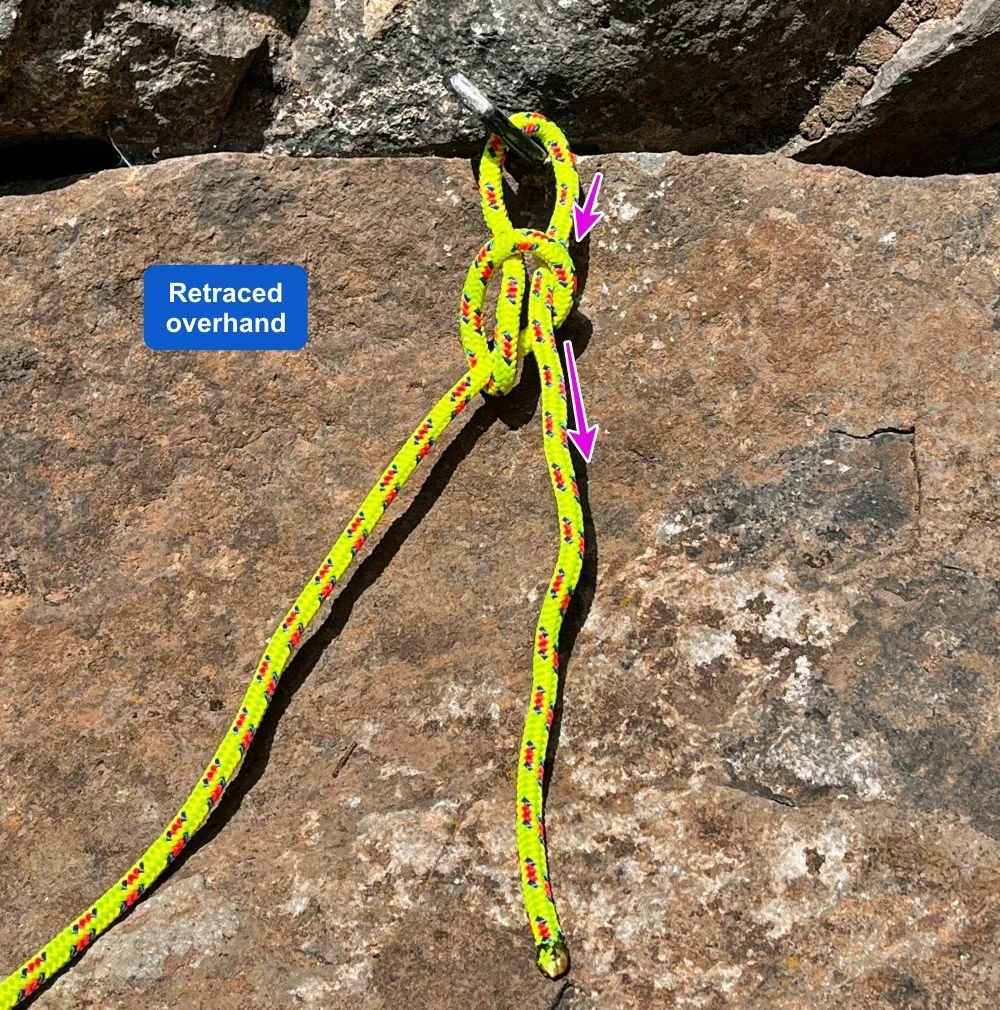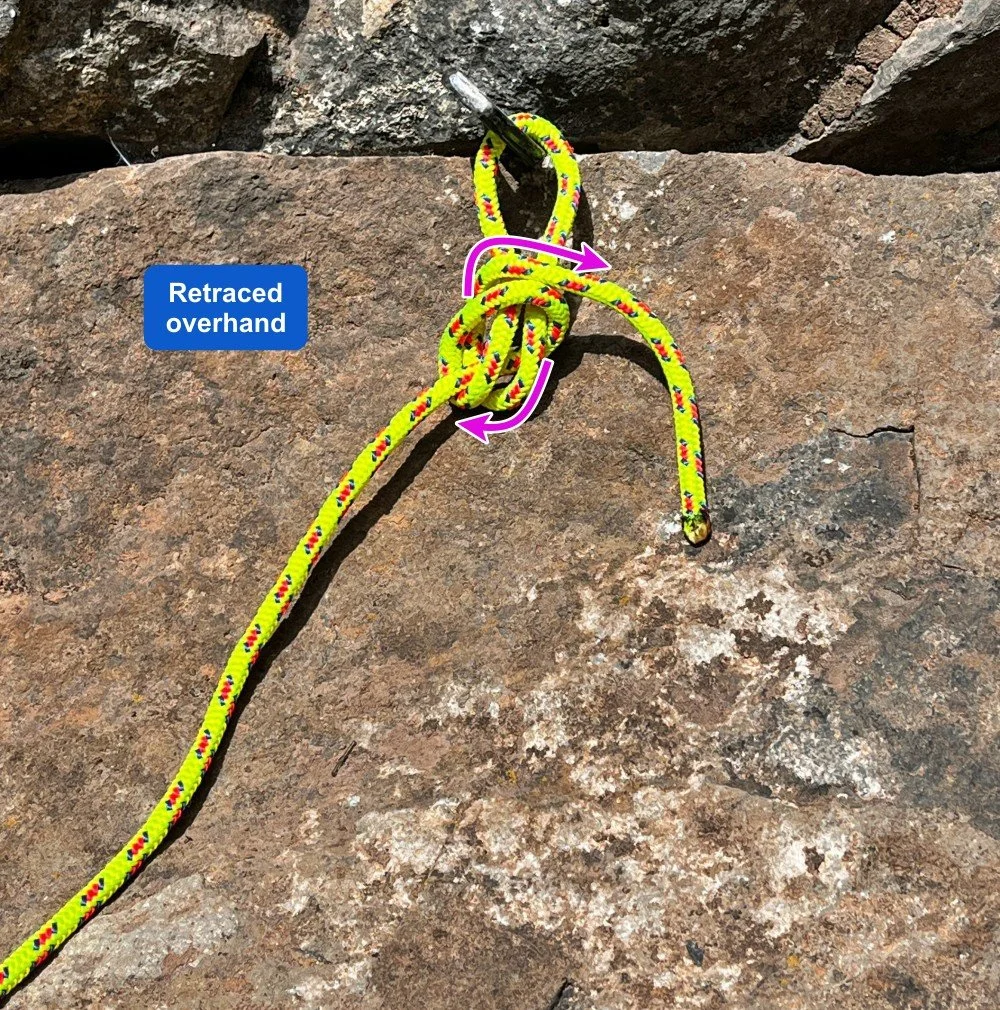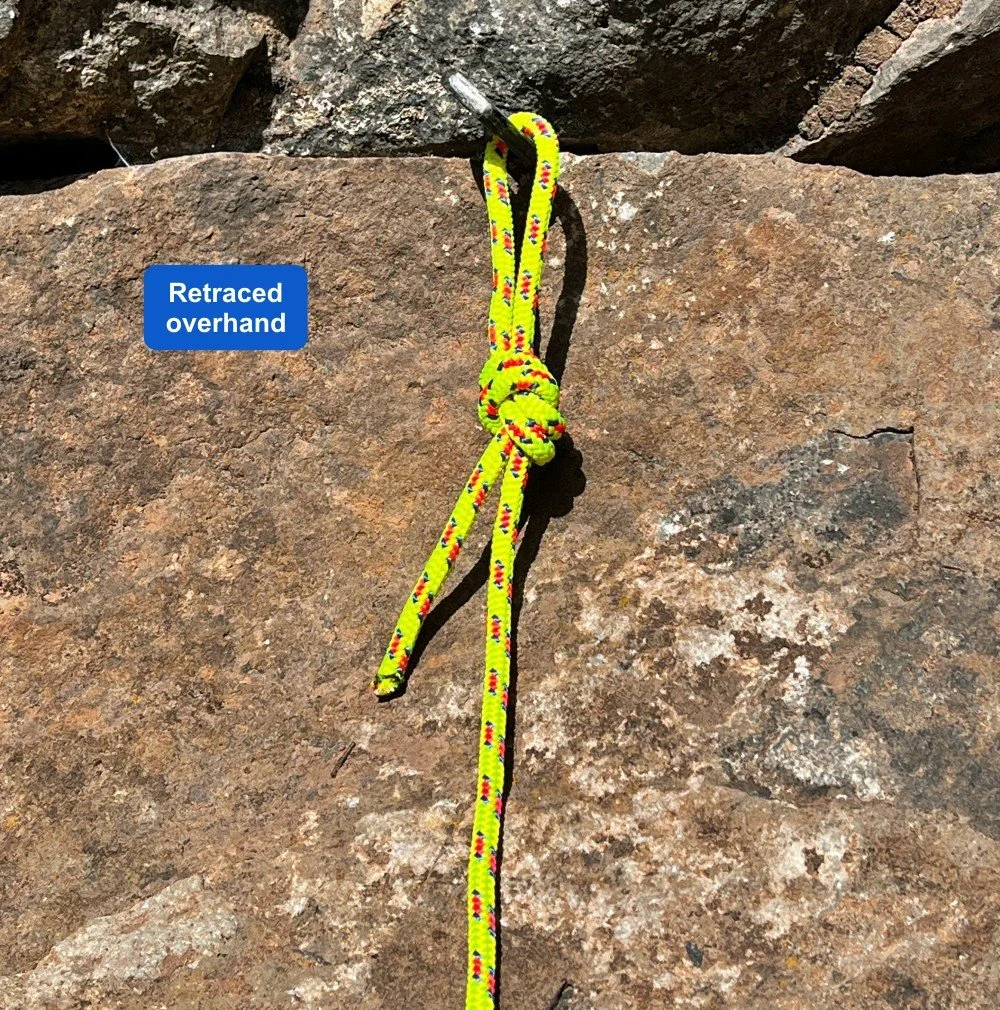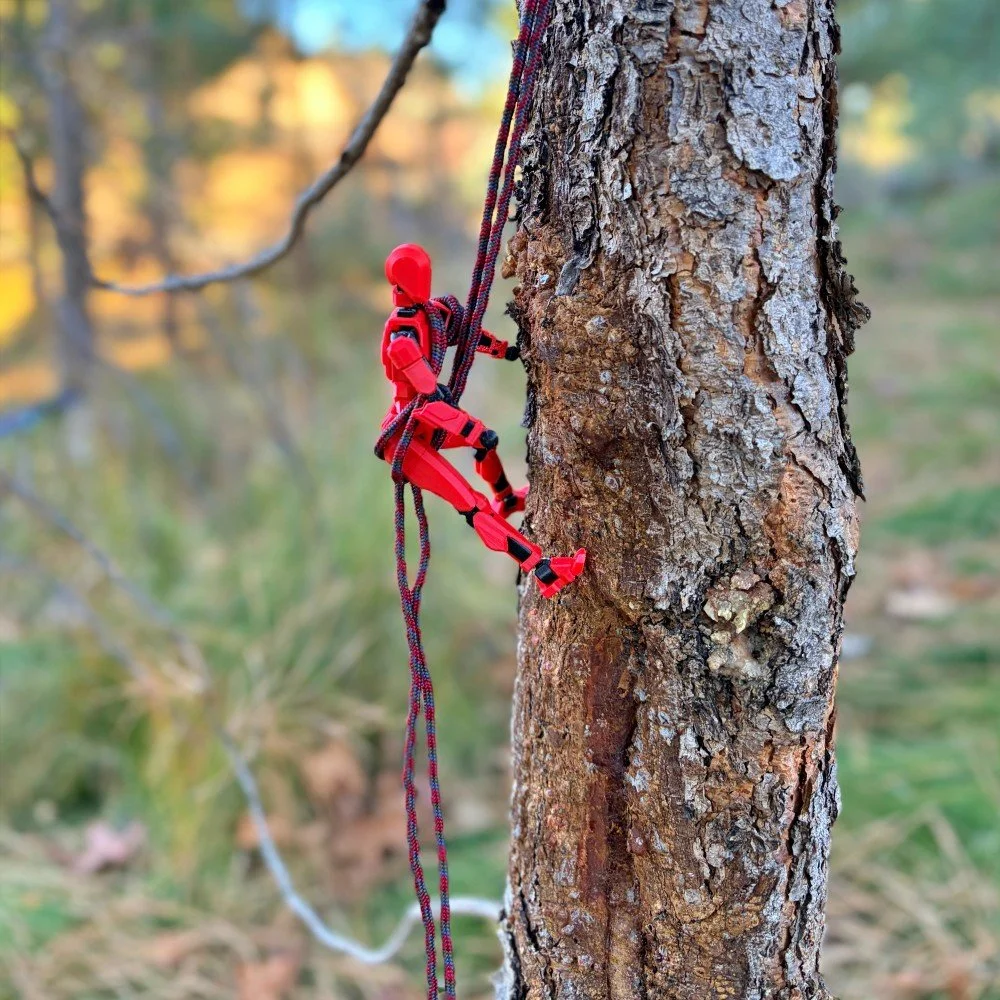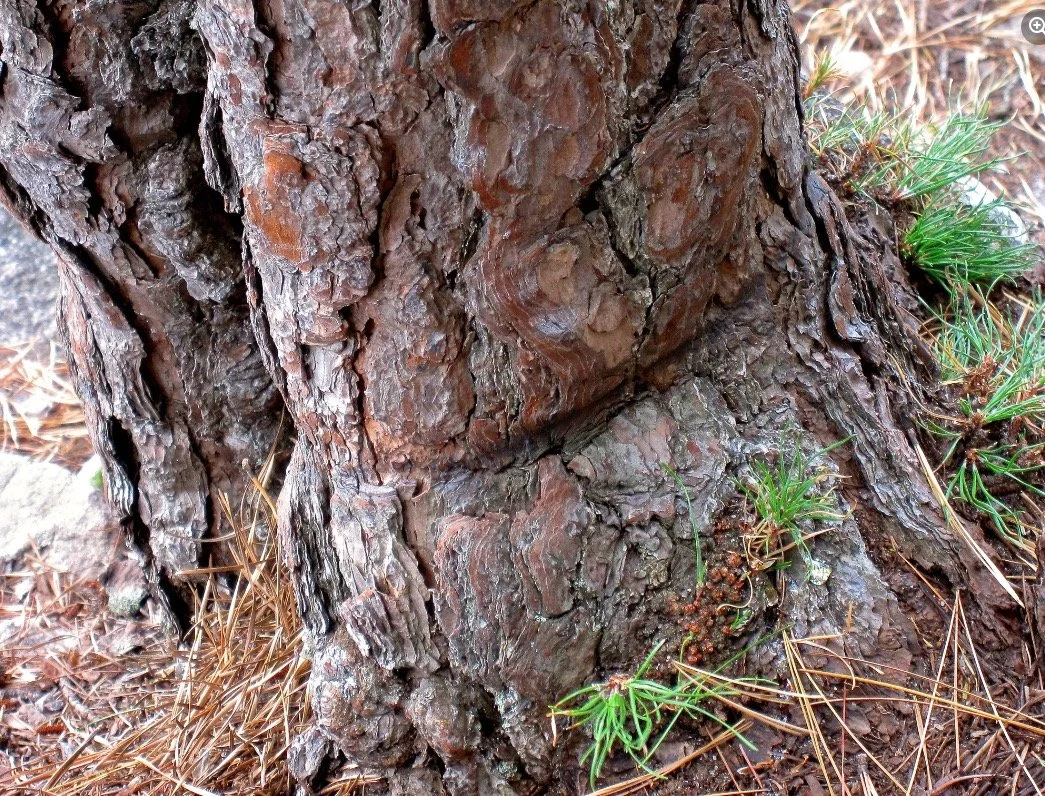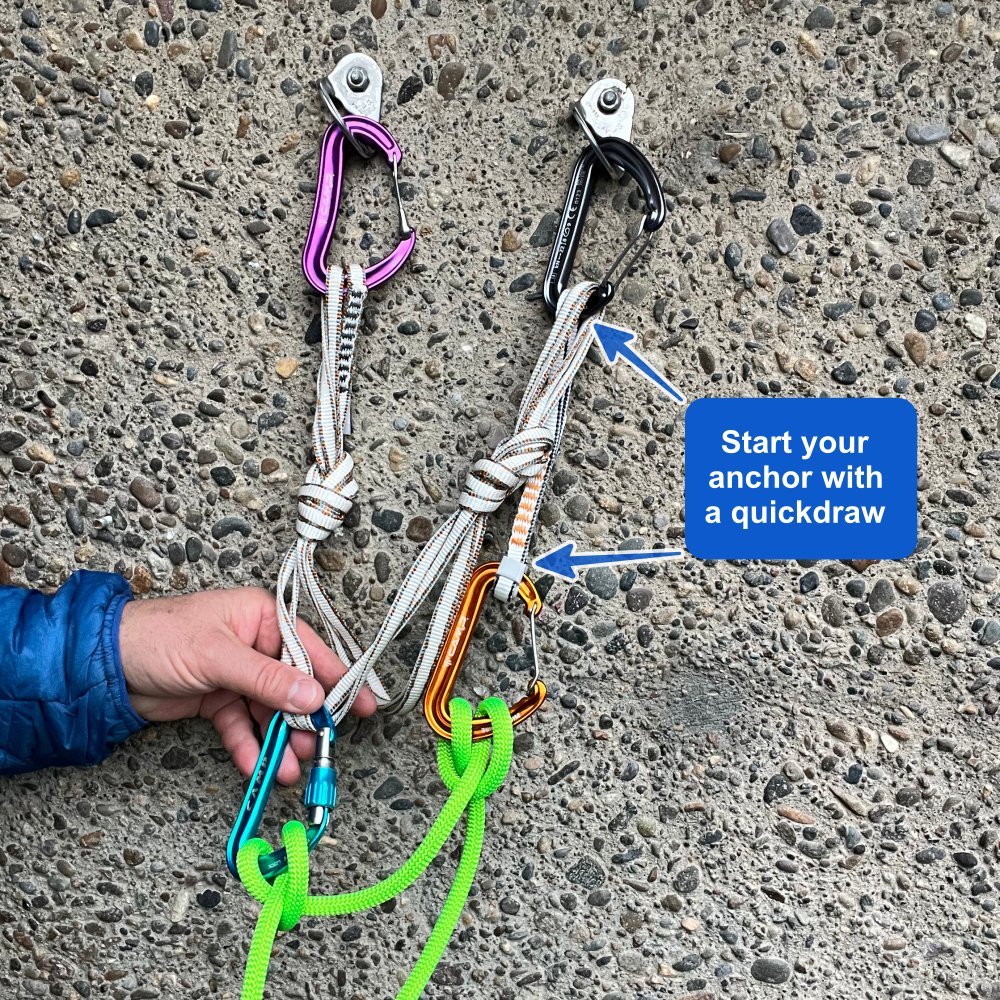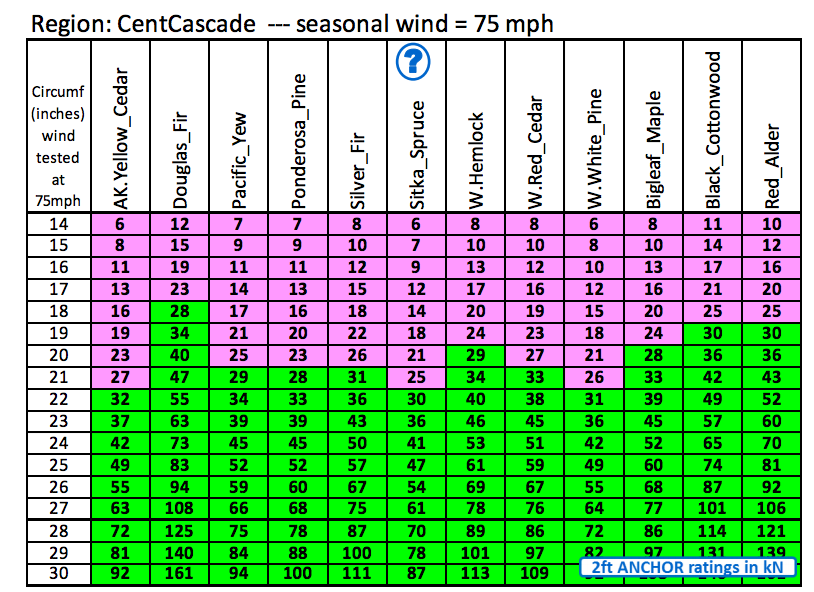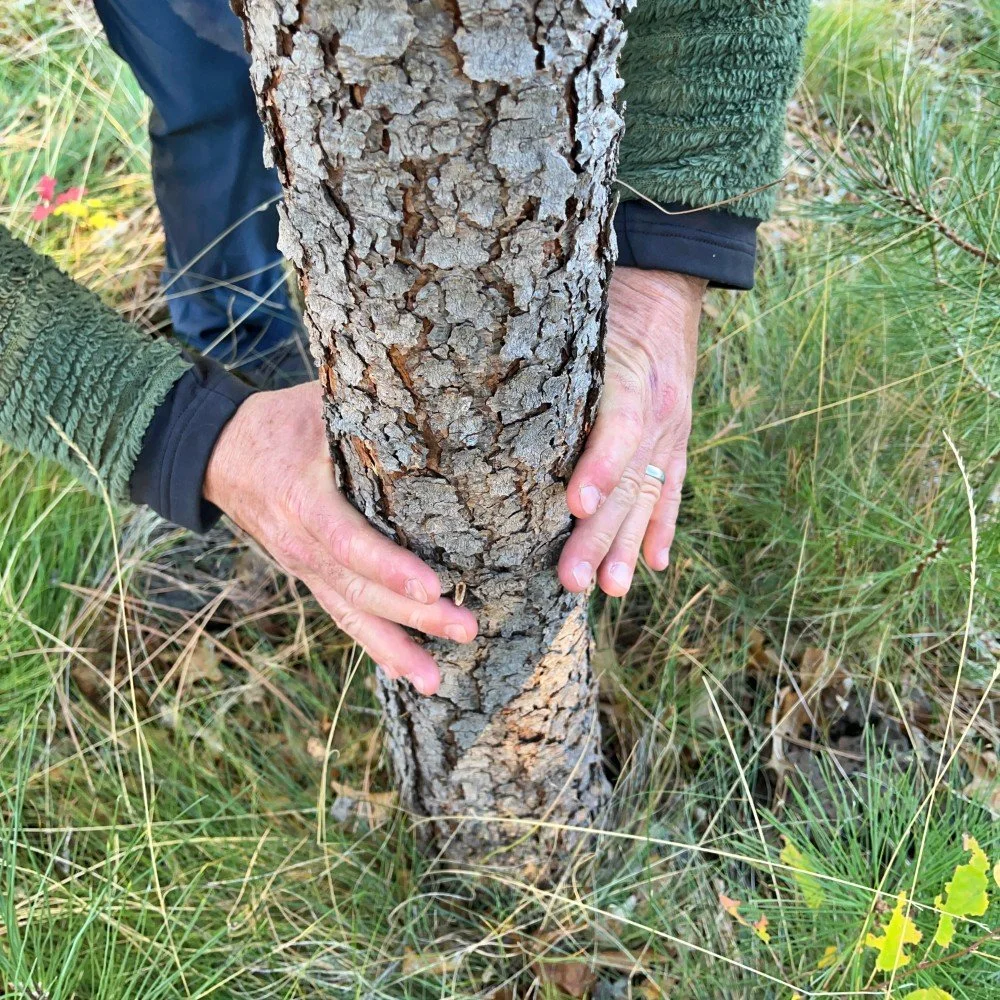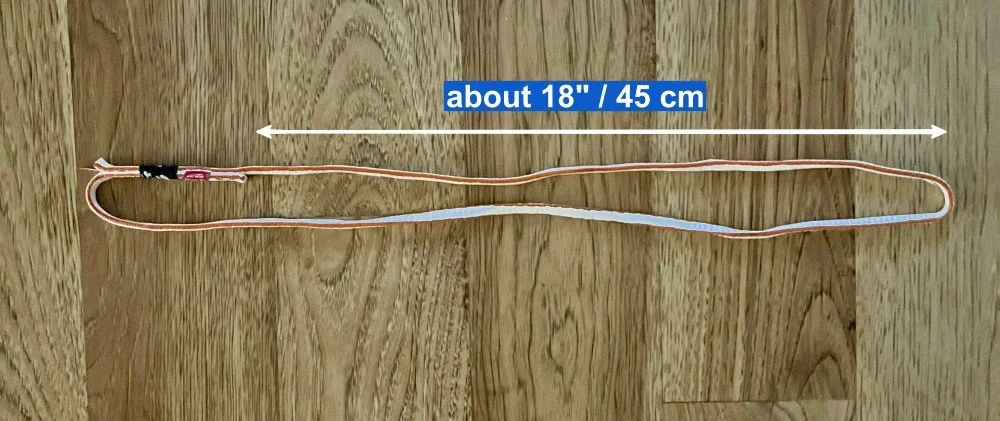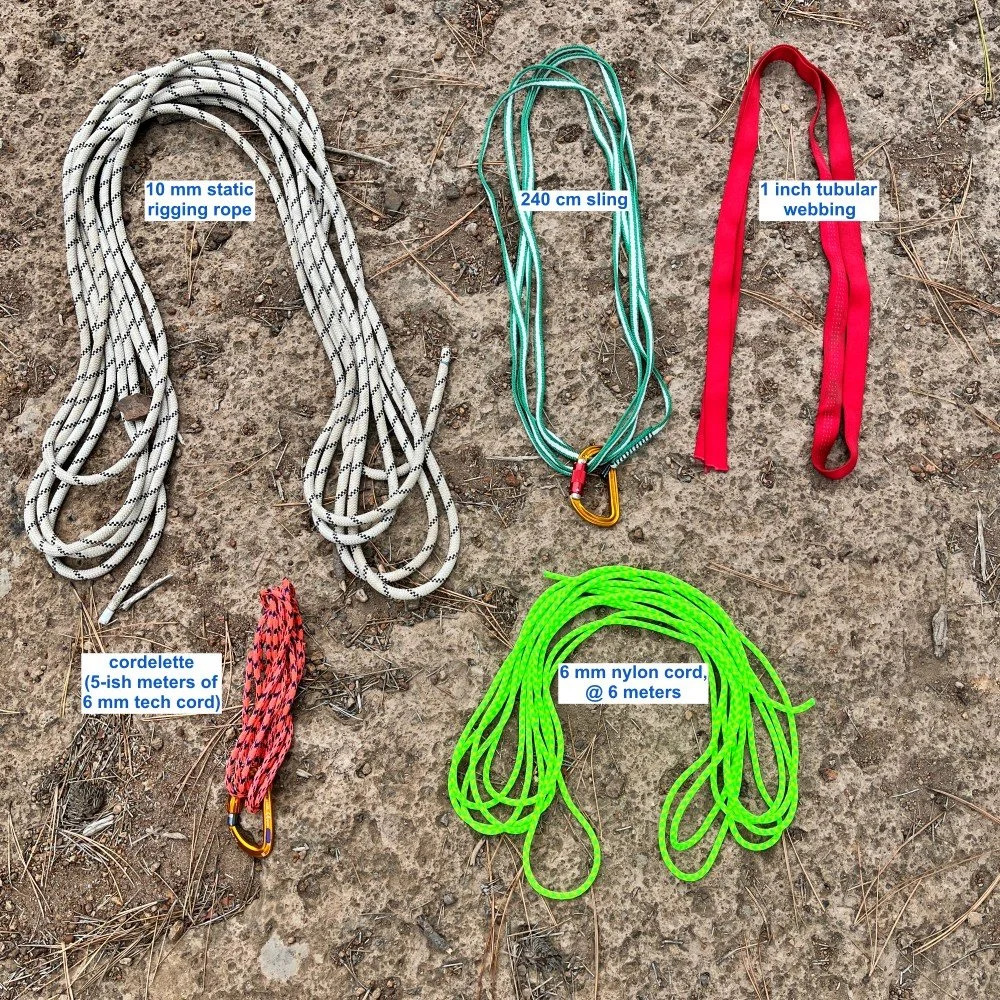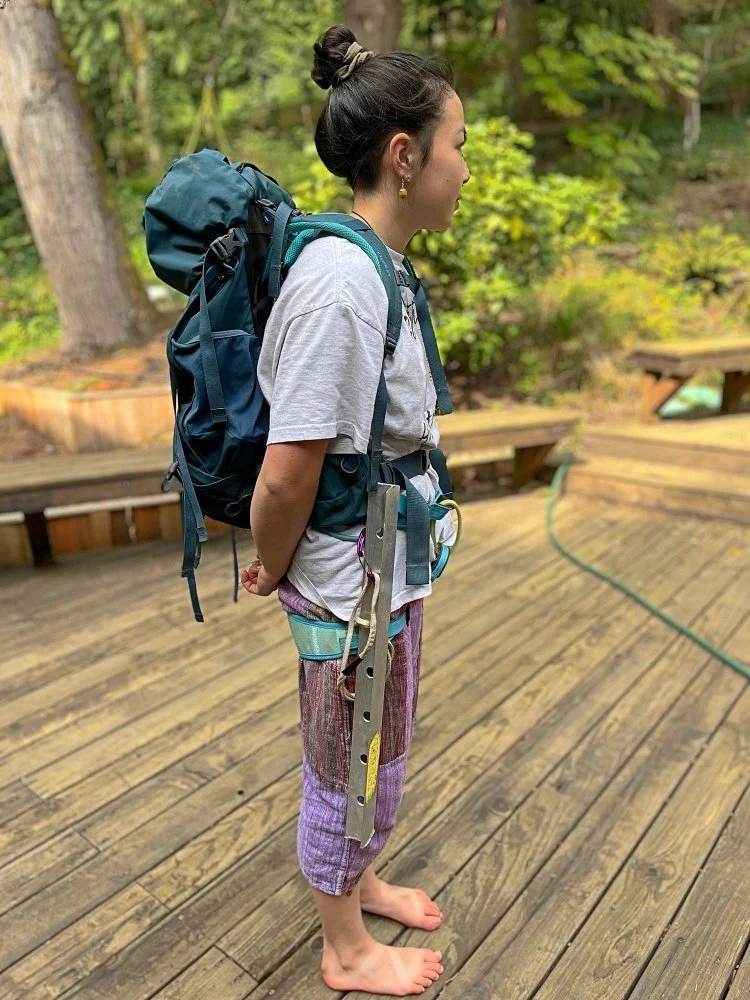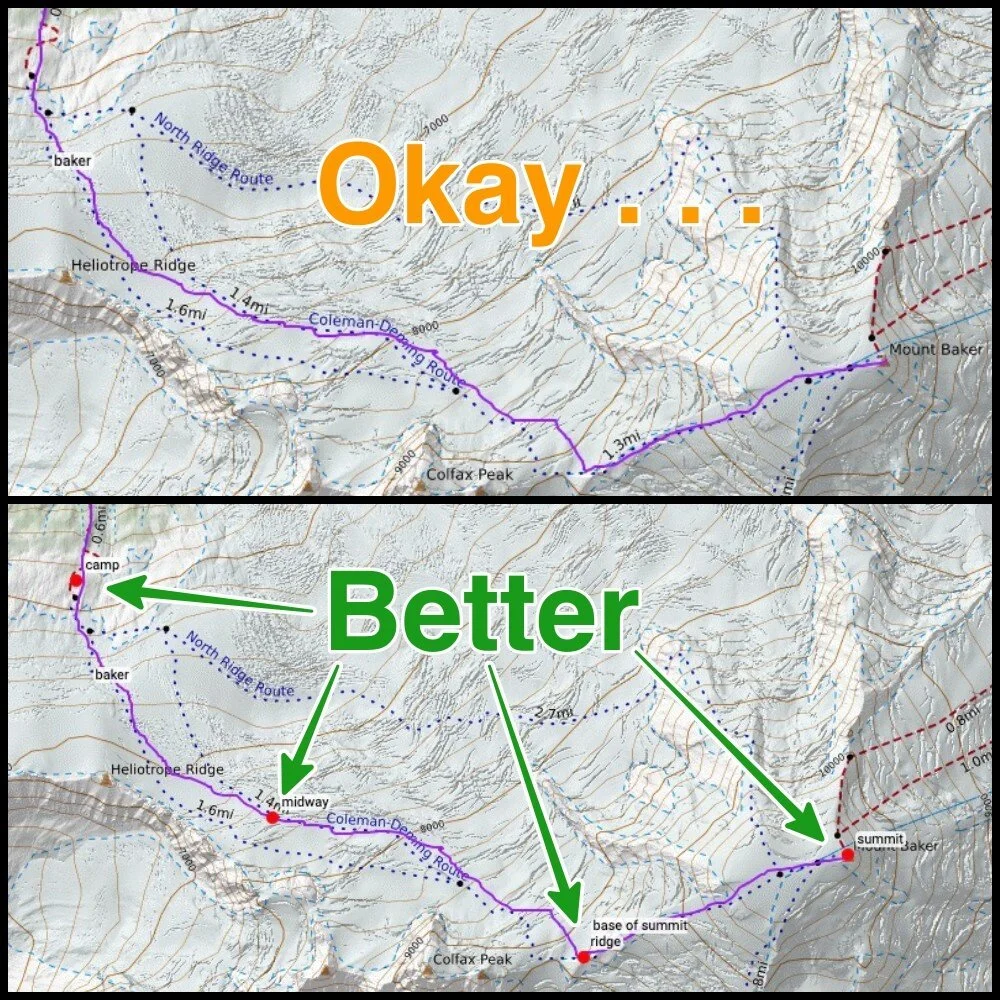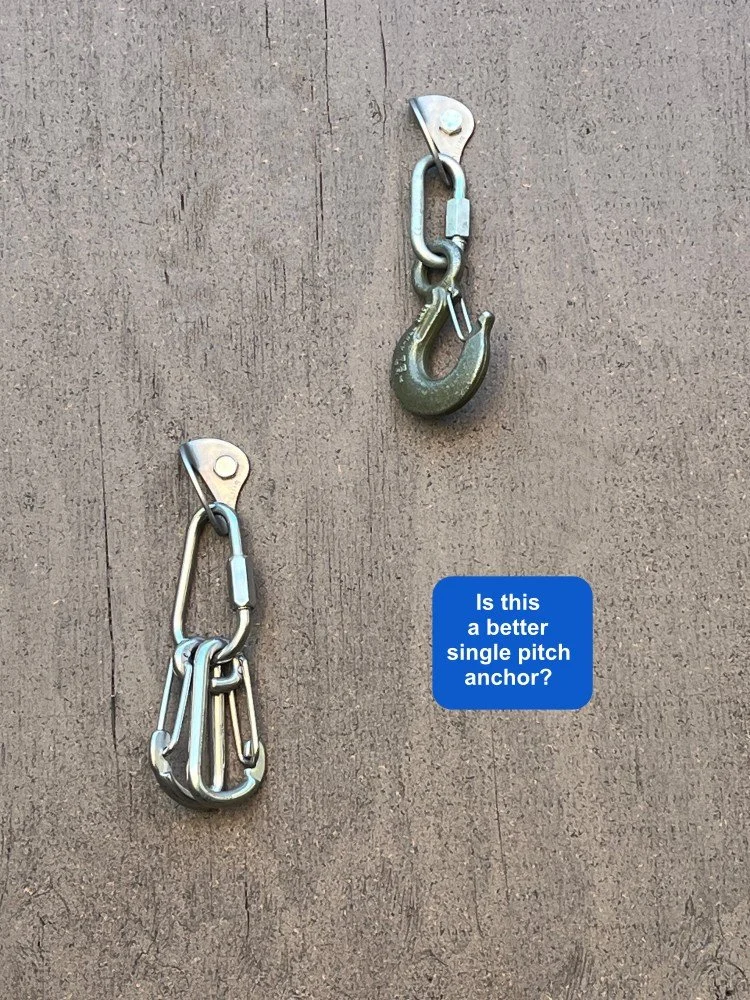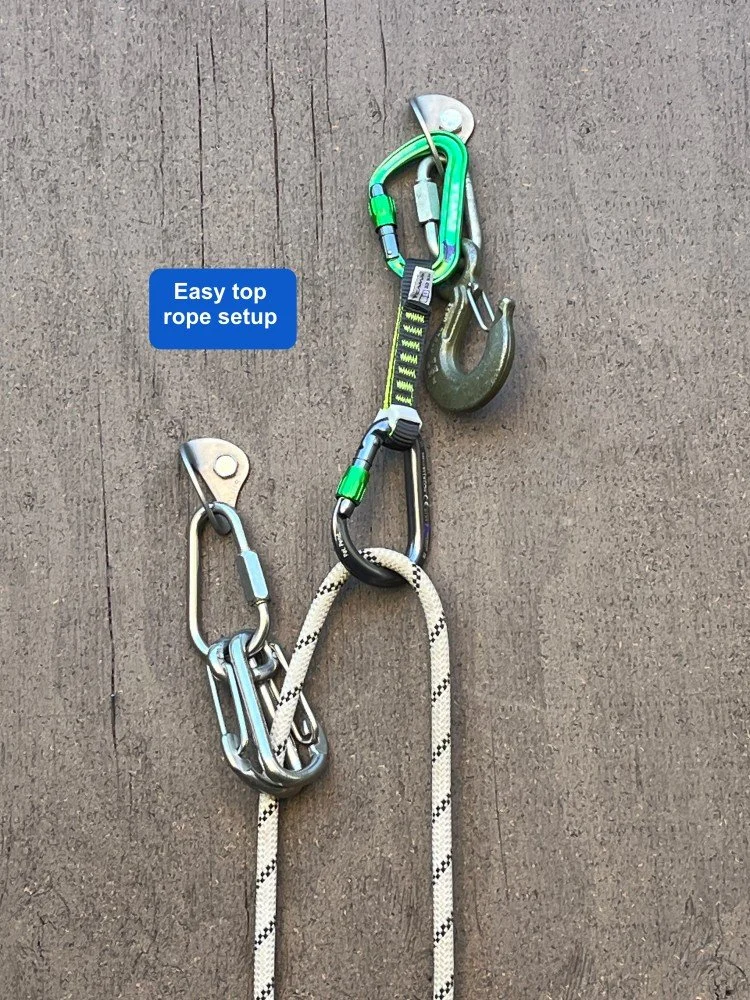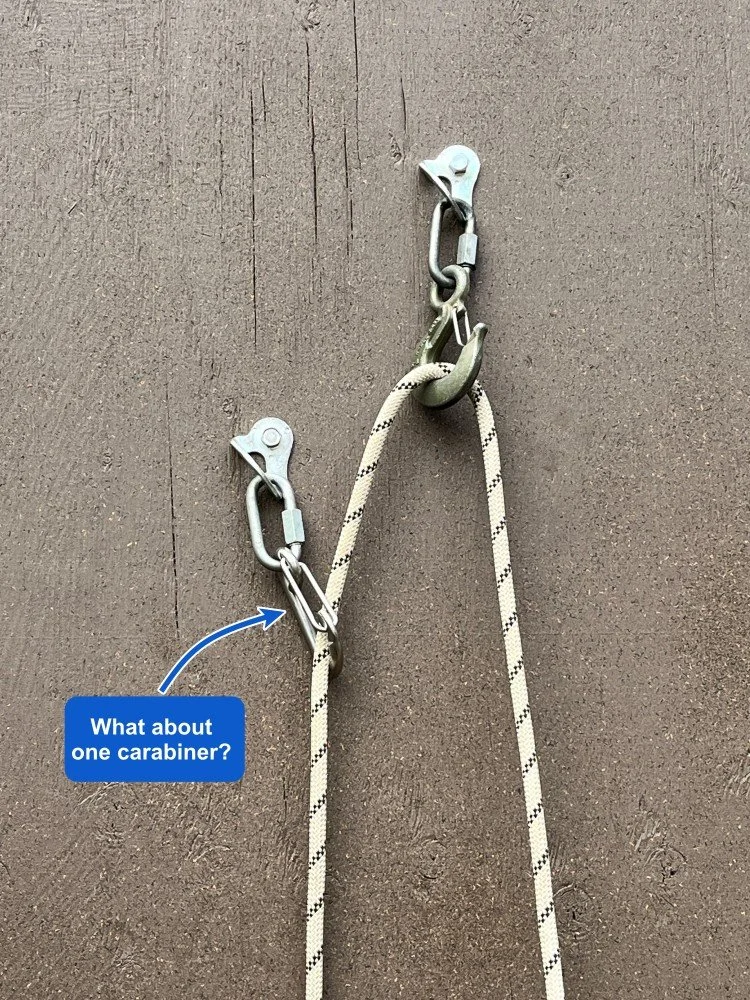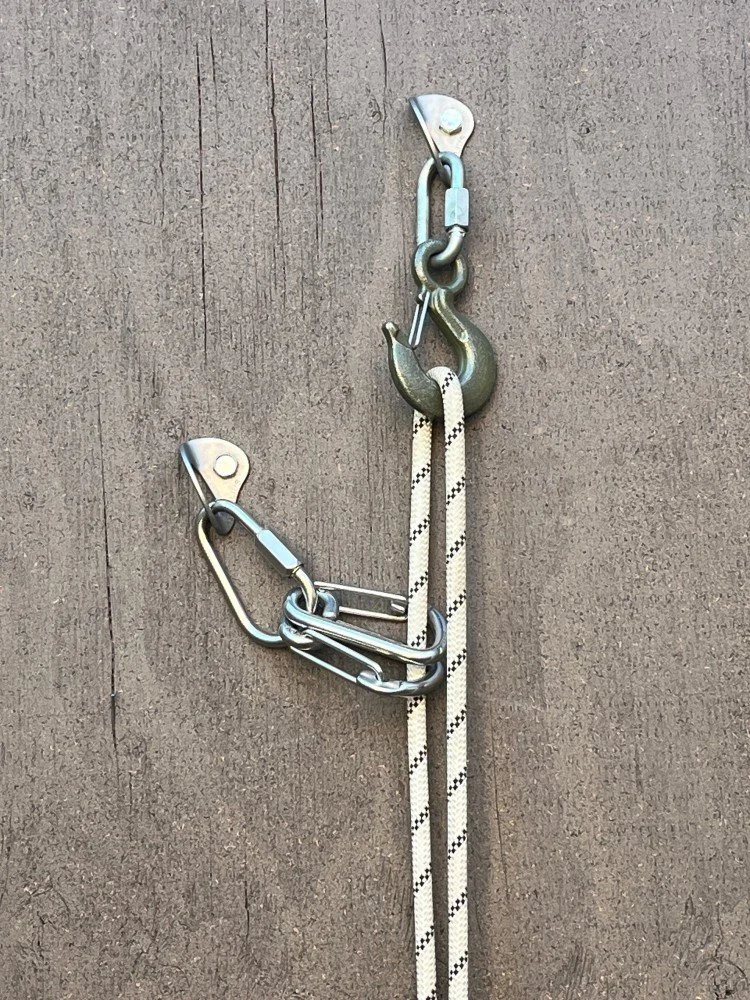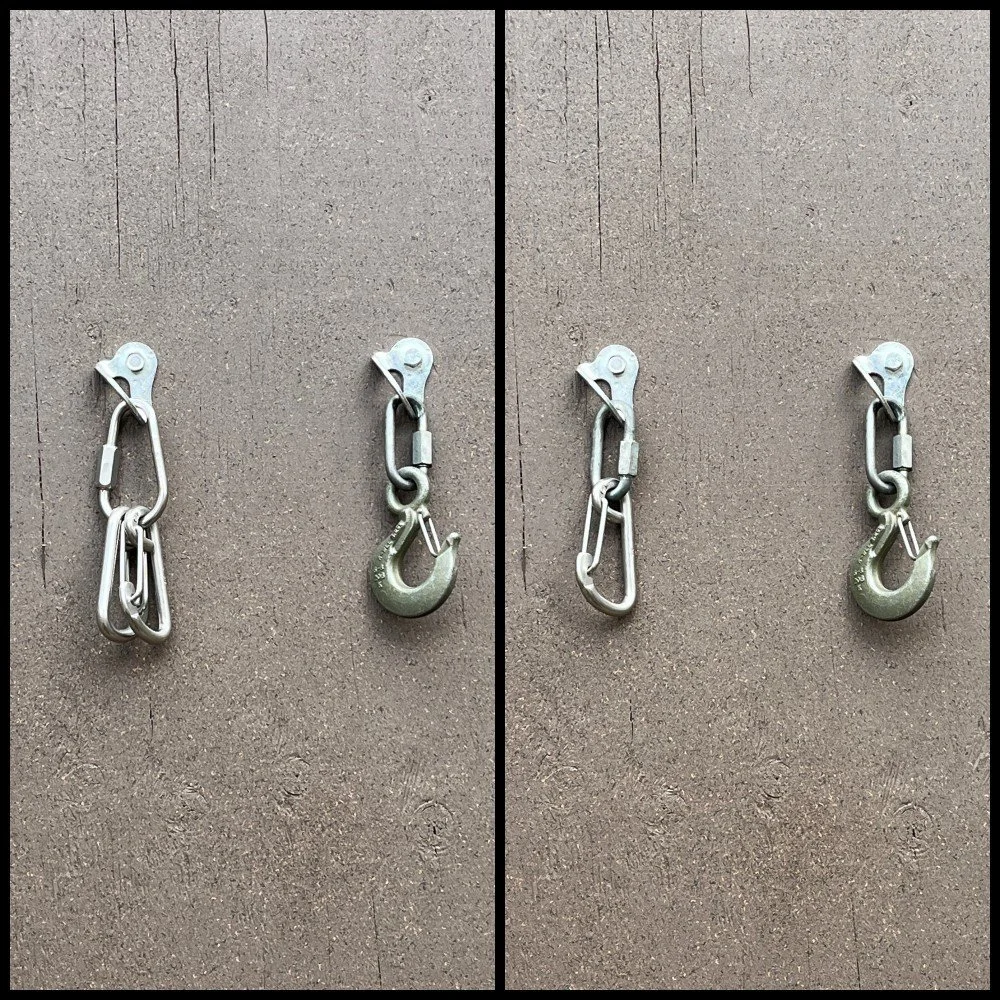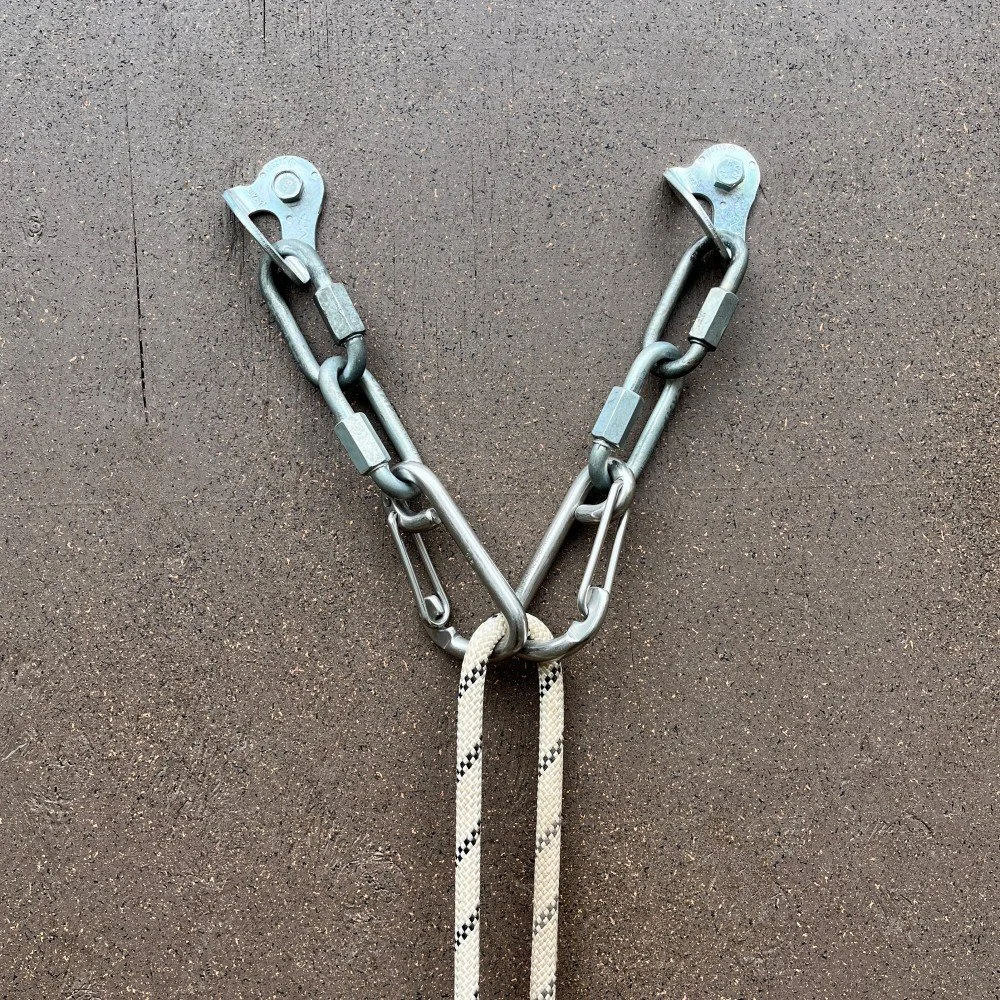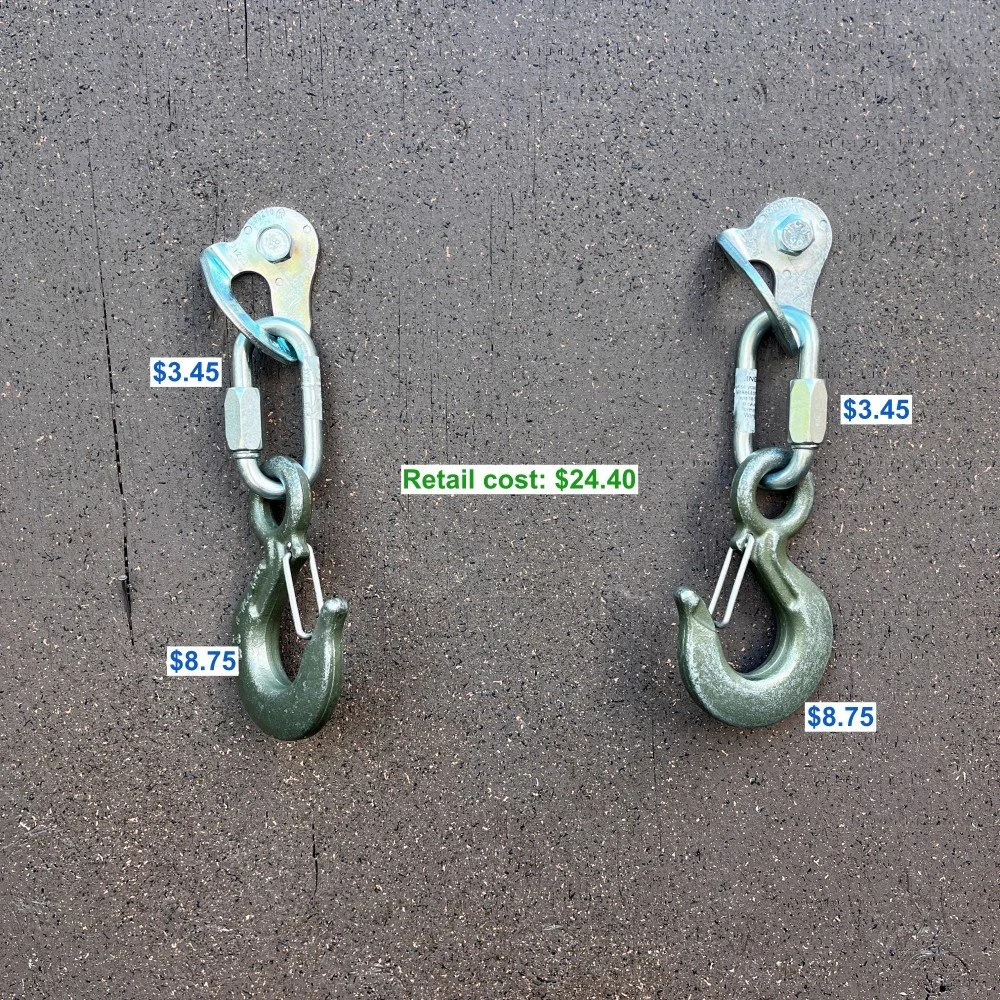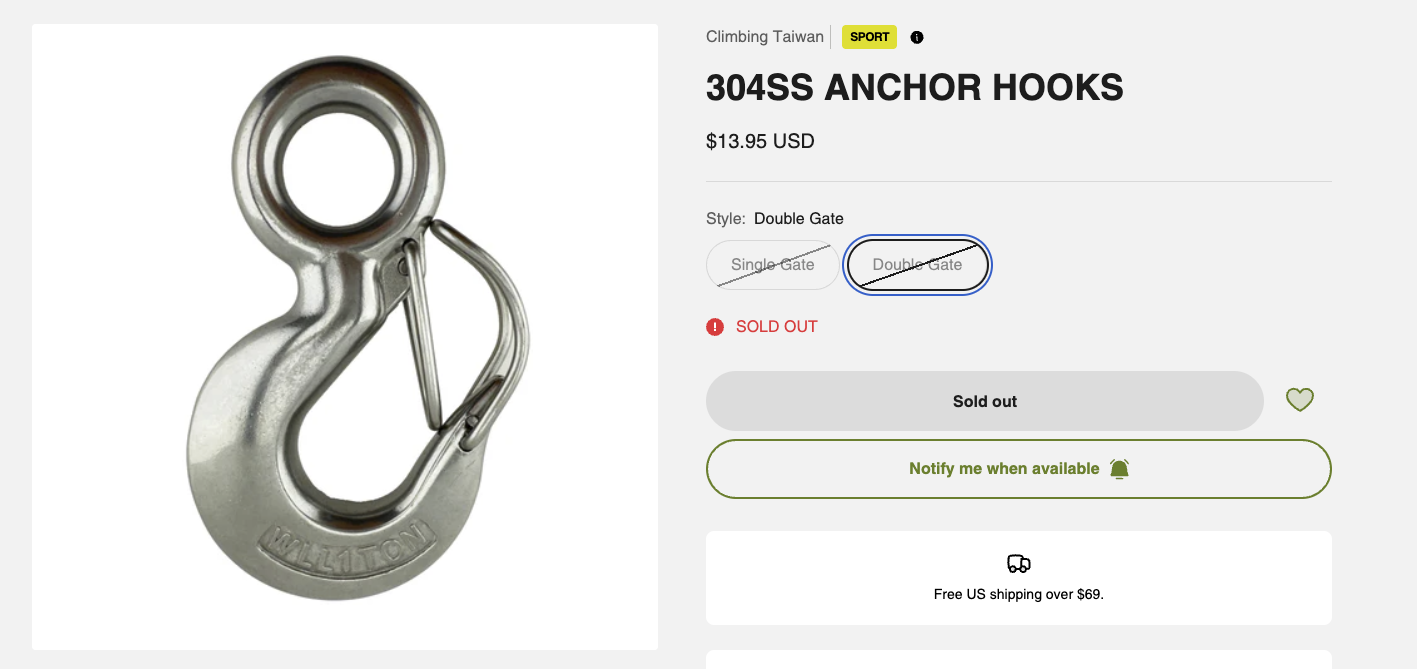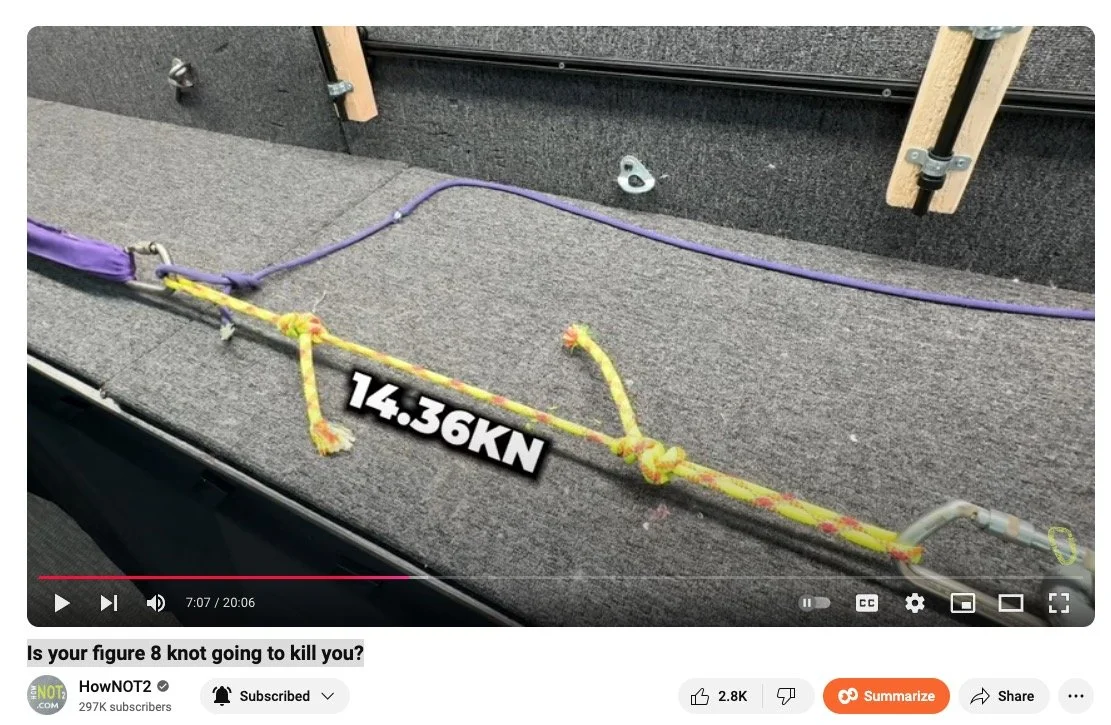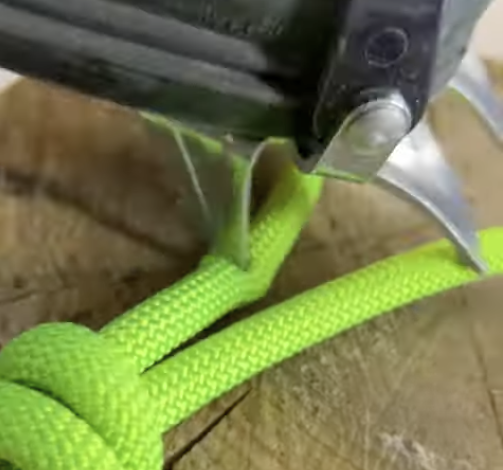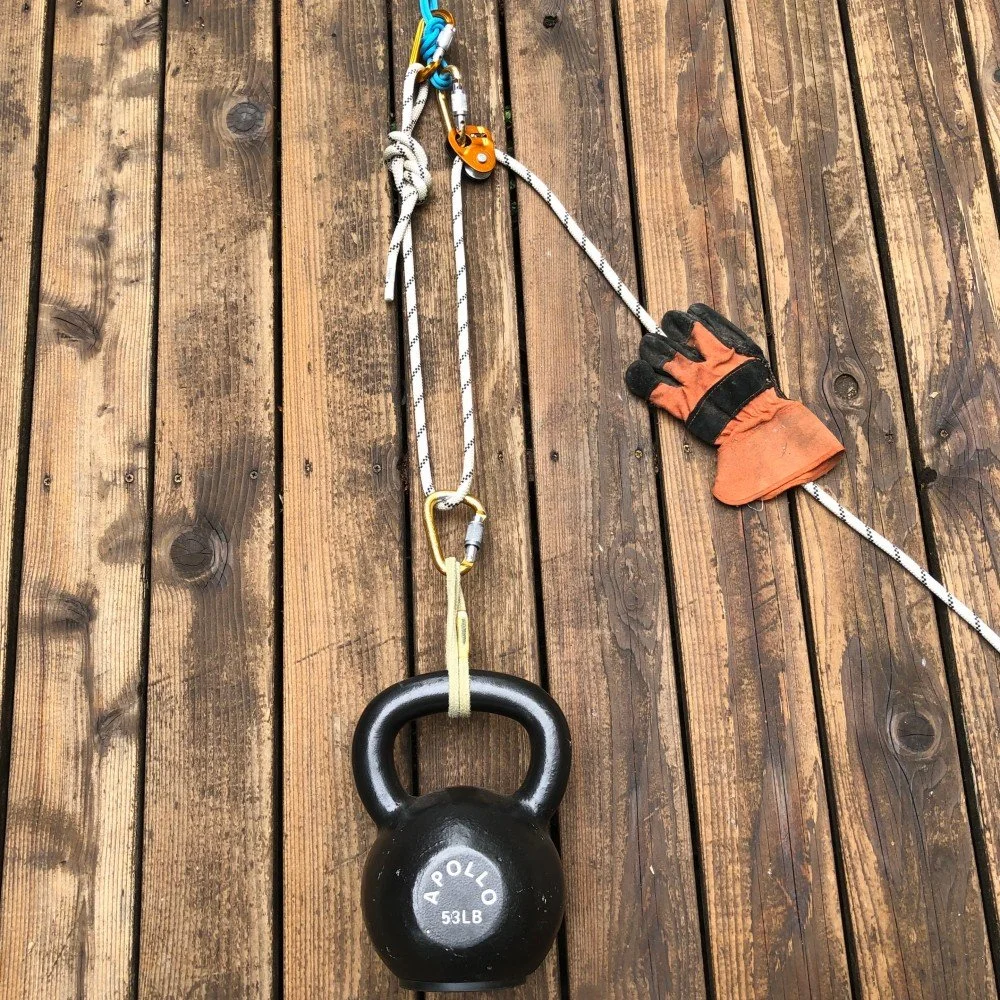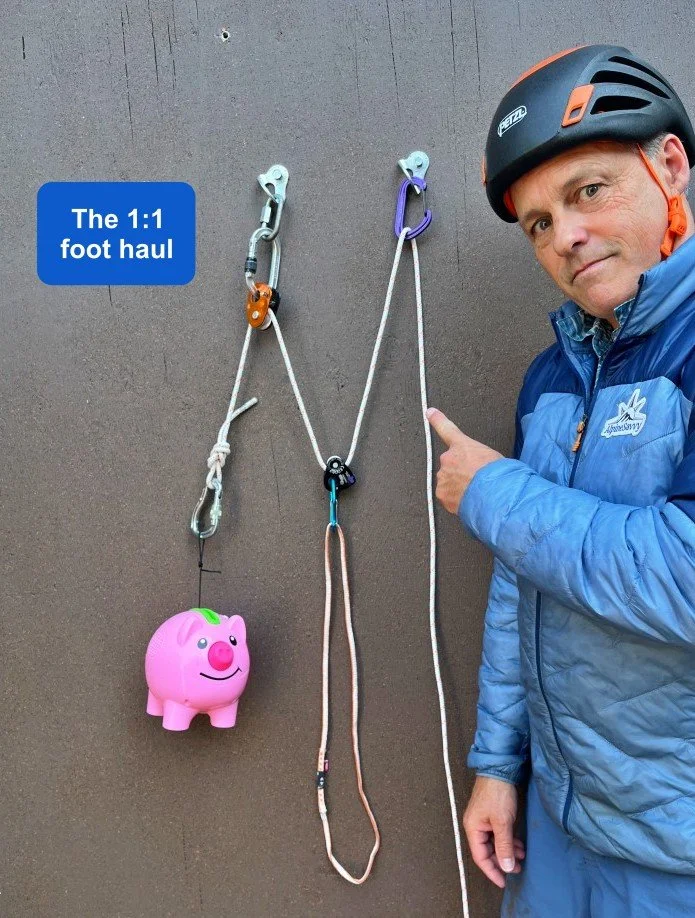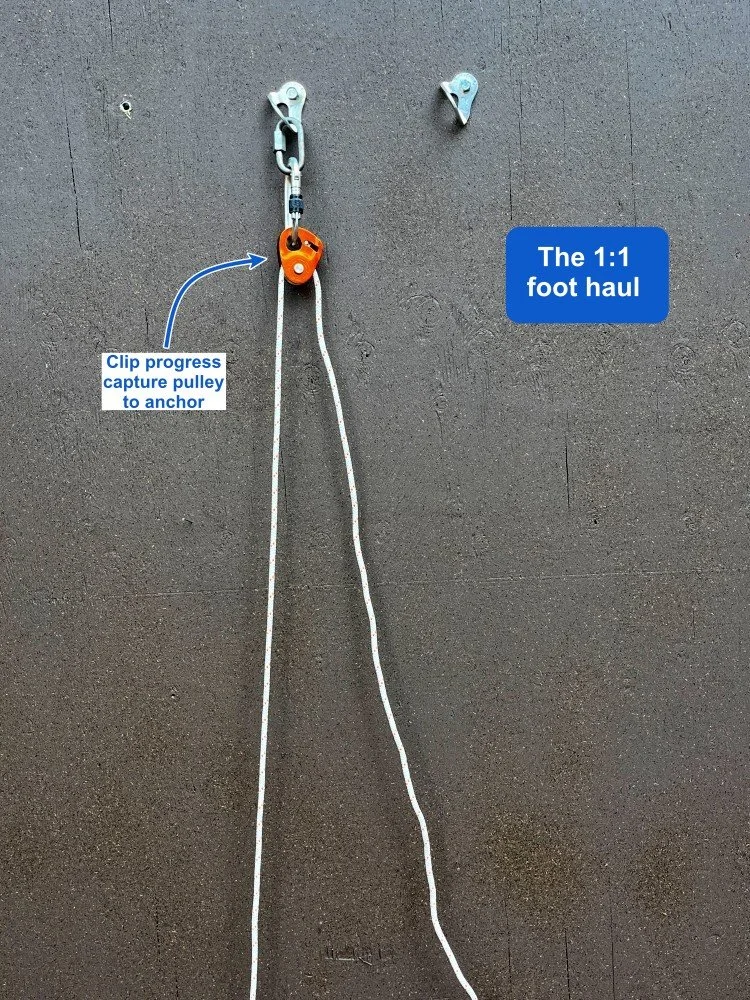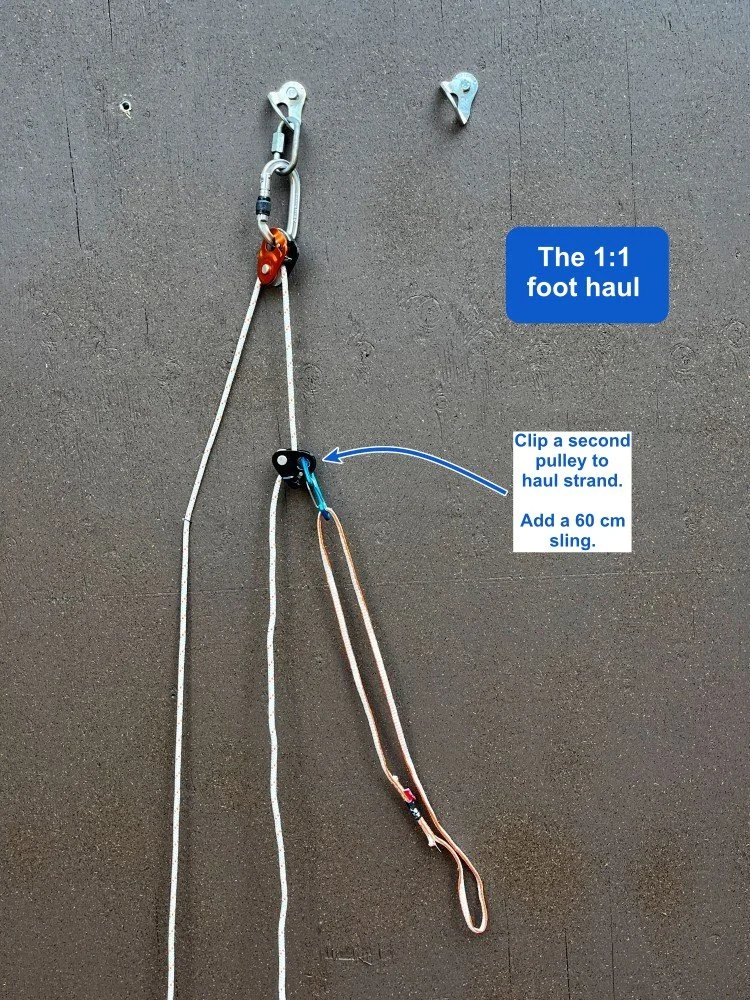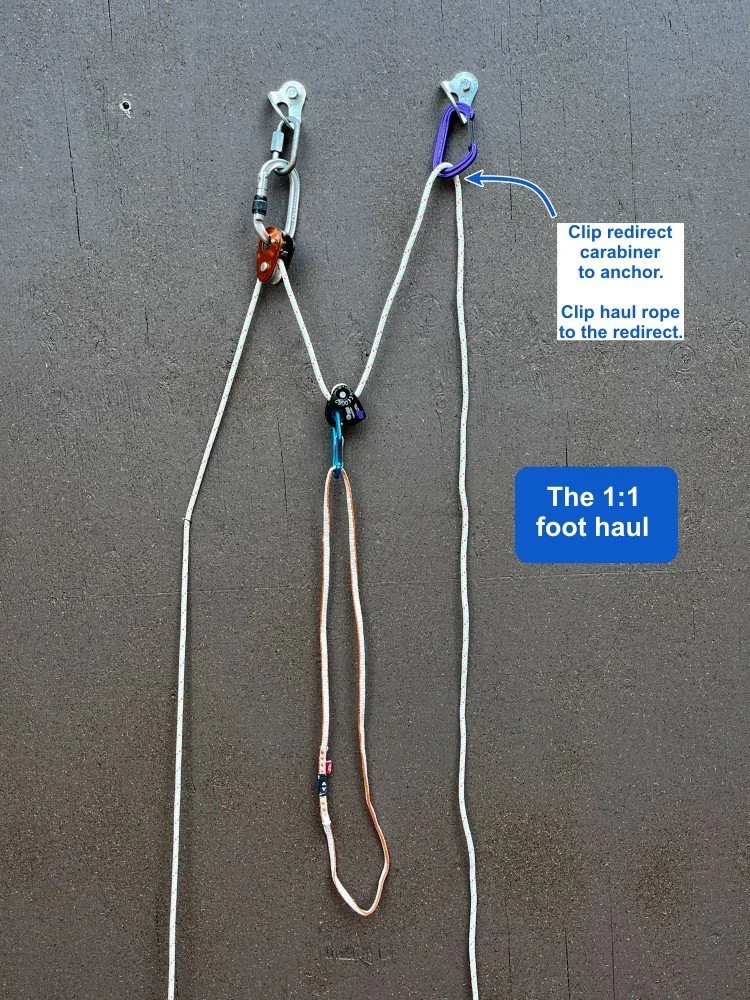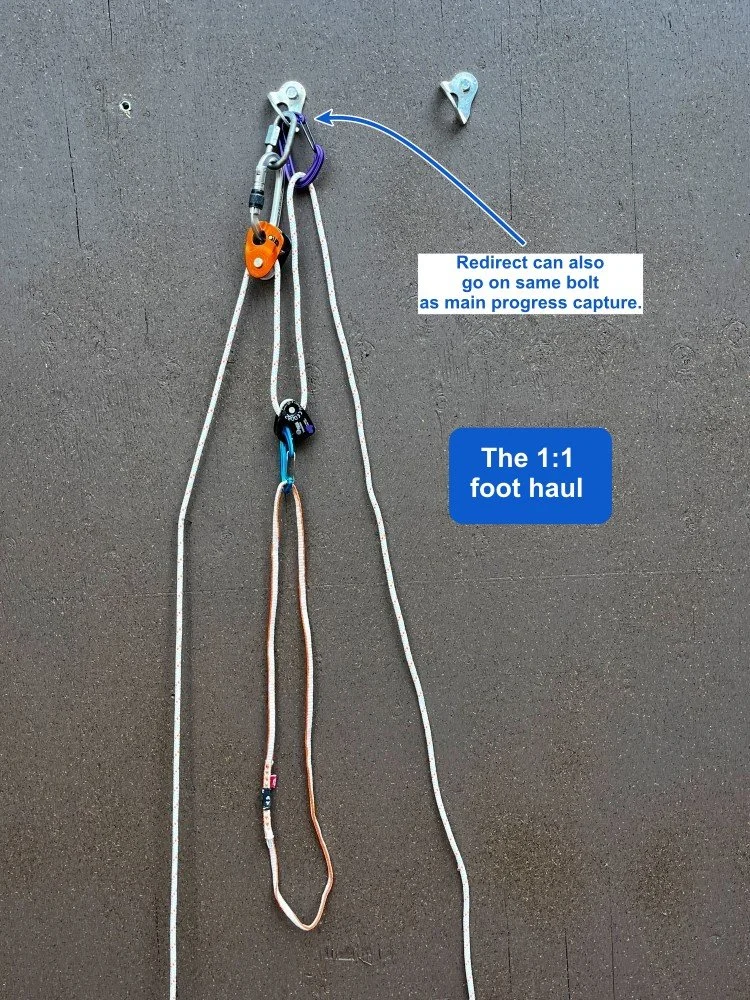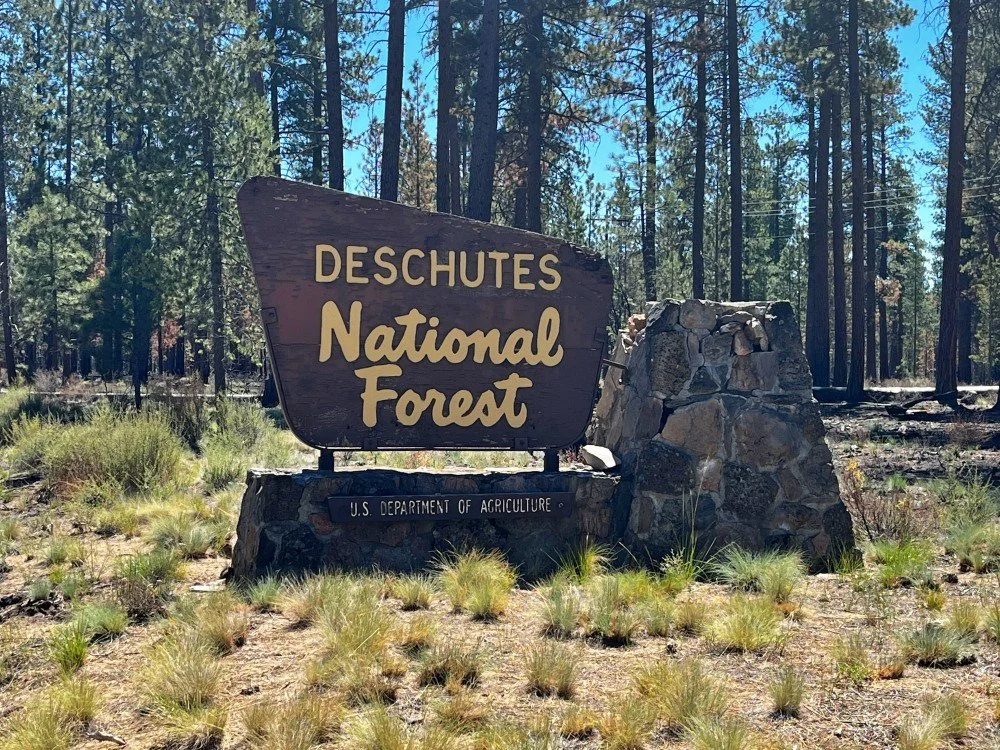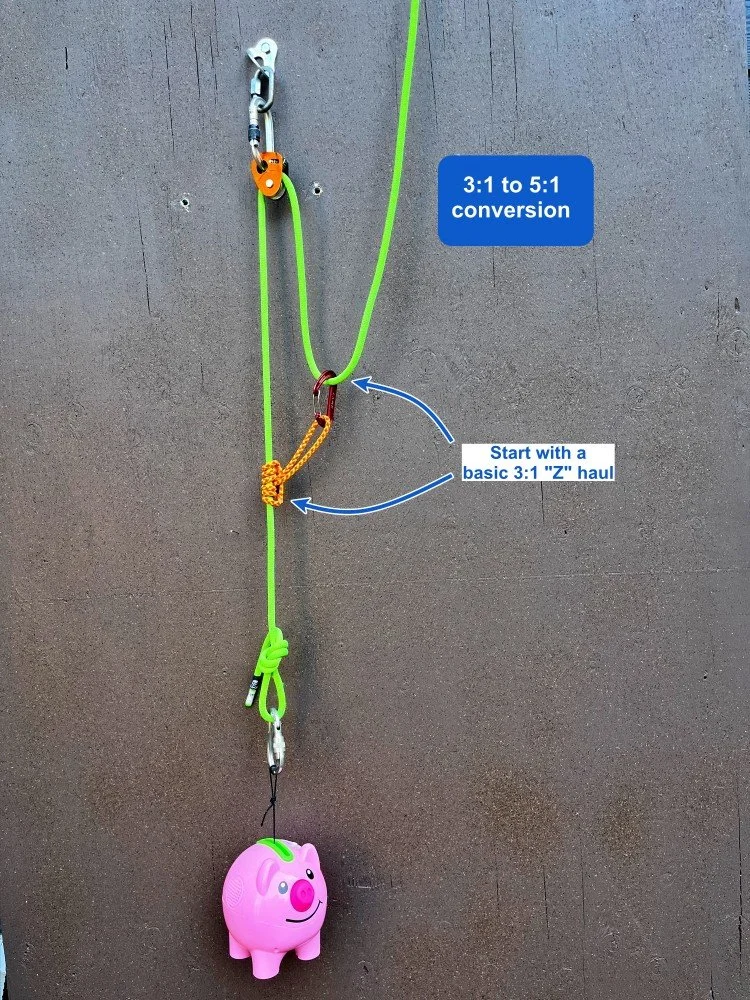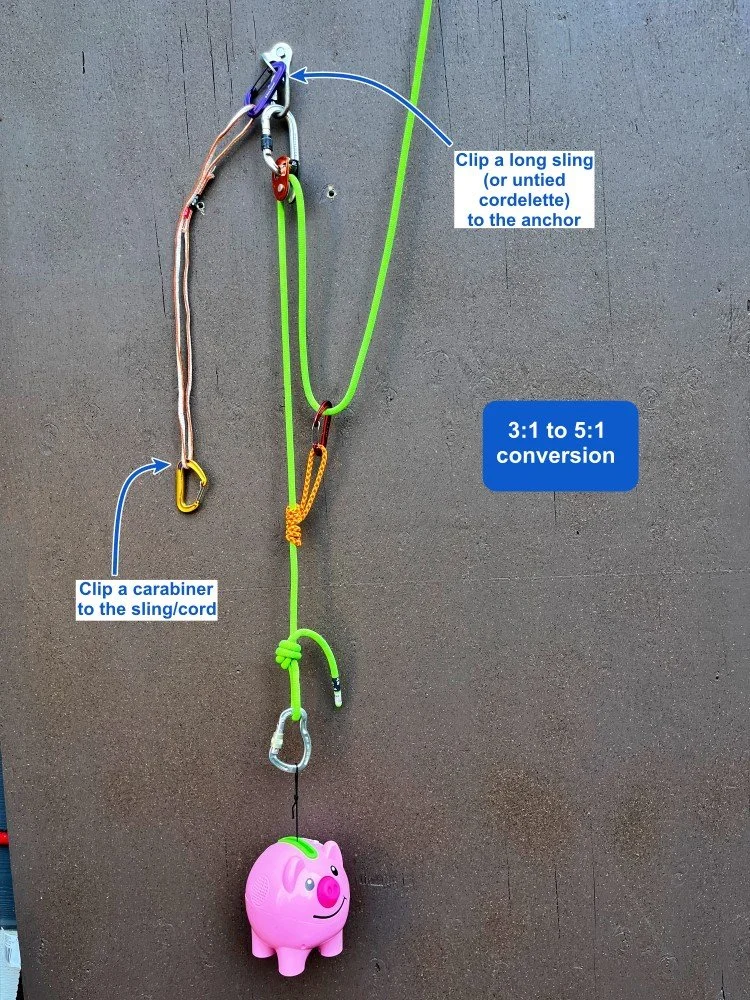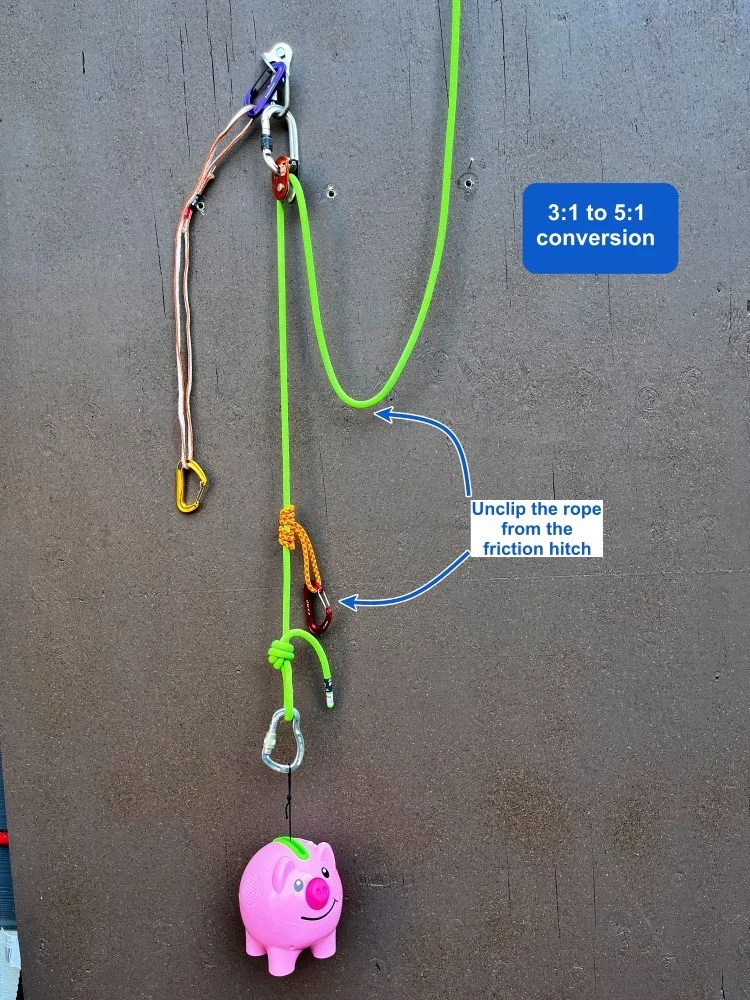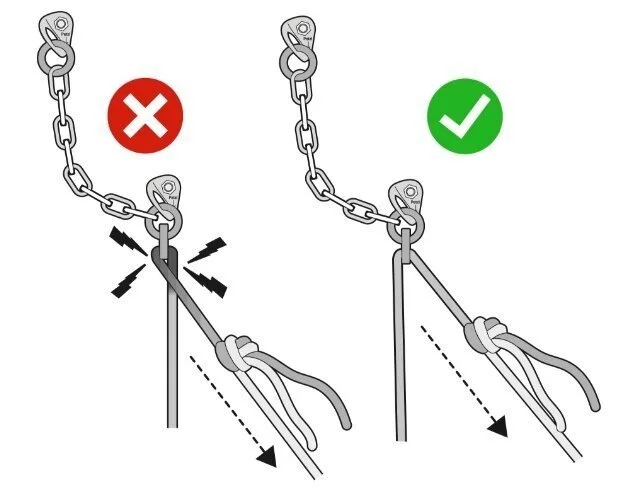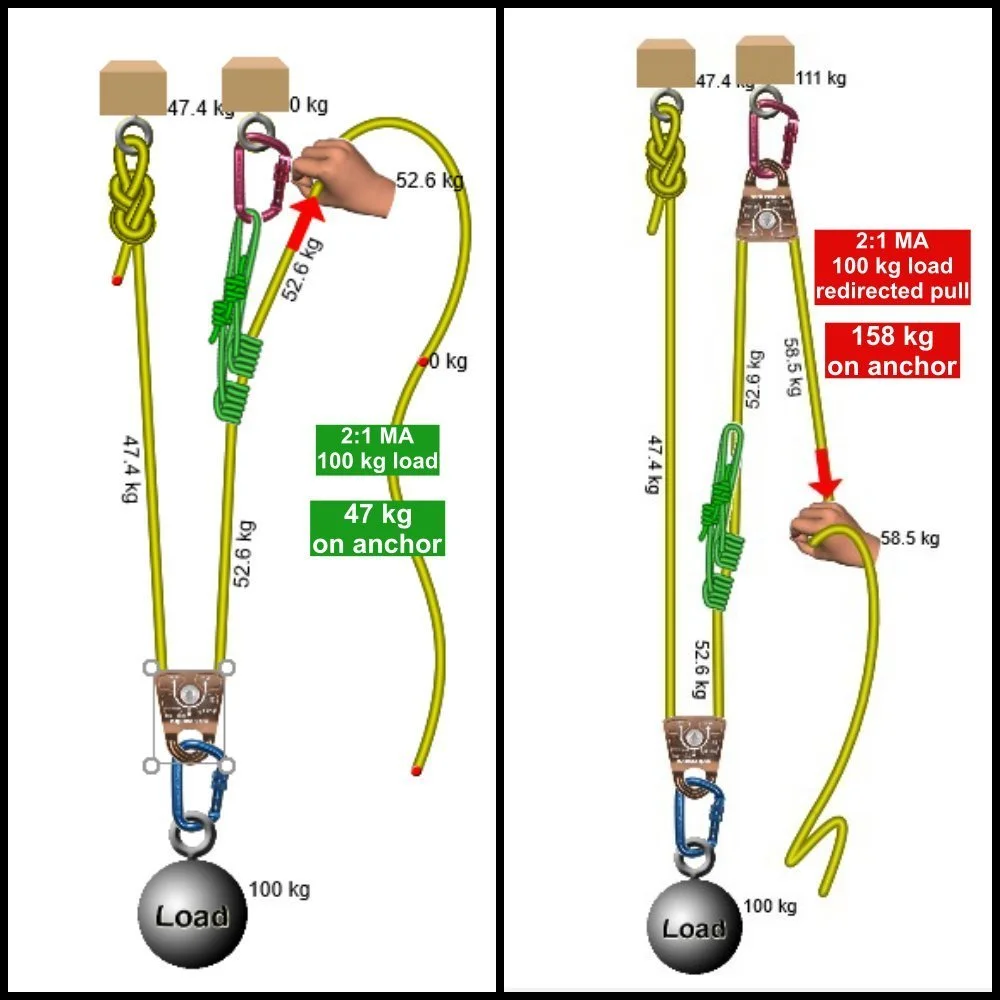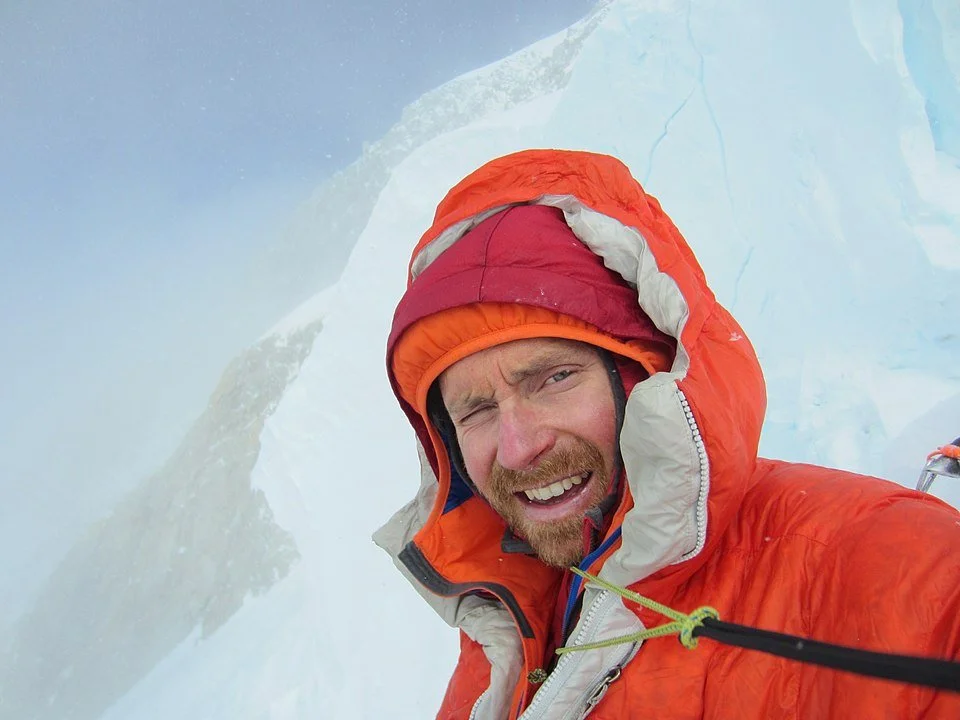
Alpine Tips
Two ways to (neatly) cut a rope
Yes, the electric hot knives in the climb shop work great. But I bet you don't have one in your garage when you need it. Here are two great ways to neatly cut a rope with simple tools and technique.
Premium Members can read the entire article here:
Sure, those nifty hot knife tools in the climbing shop are great. But if you need to cut a rope without one, and want a nice clean end, here are two ways to do it.
Rope cut method 1 - DIY hot knife
Notes:
Do this outside, nasty fumes are generated!
Wrapping with tape is the key move. This gives you a much cleaner cut.
Use a disposable utility knife, and NOT any sort of a good knife and especially one that’s ever going to touch food. The blade is going to have some discoloration and baked on melted rope yuckiness.
Stuff you need:
your rope (duh)
athletic tape
cheap utility knife with thin blade, get it at most any hardware store
piece of scrap wood
source of hot flame, like a camping stove or propane torch
Wrap a bit of tape tightly around the rope.
Heat up the knife blade in the flame. Orange hot is good.
Press / slice the hot knife down in the middle of the taped section. The hot knife should nicely melt through.
If needed, you can heat the knife up again and press the side of the blade against the cut end.
That's it! The end of your rope should be completely cauterized and ready to use.
Rope cut method 2 - Superglue
Notes:
Do this outside, and on a work surface you don't mind dribbling some glue on, because you probably will.
Important: the chemicals in superglue may not play nicely with most ropes. In this case we're using them only at the very END of the rope, which will never see a load. When you're doing this, be careful not to get glue on any other part of your rope.
Stuff you need:
your rope (duh)
athletic tape
sharp knife. Disposable utility or razor knife works well. Scissors generally don’t work well.
piece of scrap wood
Superglue
Wrap some tape tightly around the rope where you want to cut it.
Cut through the tape.
Holding the end of the rope vertically, scoooooge glue into the rope end, covering the core and the sheath.
Wait at least a minute before you take the tape off or you'll probably get some glue on your fingers, ask me how I know about this.
Sweet, give yourself a high five. You now have a perfectly sealed rope end.
What’s a common method used to cut and seal a rope that really doesn't work very well?
What's the best kind of superglue to use on ropes?
Which of these two methods should you use to cut an Aramid/Kevlar rope?
If you need to cut a lot of rope or webbing, what’s a low cost tool you can use to do this easily (that's not an expensive climbing shop rope cutter.)
Join my Premium Membership to read the rest of the article.
Thanks for your support!
The retraced overhand knot
A close cousin of the retraced figure 8, the retraced overhand knot has a few niche applications, like making retreat anchors. Learn about it here.
Premium Members can read the entire article here:
All climbers know the retraced figure 8. Meet the cousin: the retraced overhand.
Here I’m using it to tie a 6mm anchor cord through a fixed piton. You could tie a retraced figure 8 here as well and it would be fine.
However, the retraced overhand is a little simpler to tie, and it uses less material. So in this particular application, it may be a better choice.
It’s also is gonna be a little harder to untie after loading, so that's the trade off. In this case, you're leaving it behind for a rap anchor, so untying it is not an issue.
Being able to directly tie to fixed gear like this is one more benefit of carrying an open cordelette, as I detail in this article.
This knot is closely related, but a bit different from the “brotherhood” or “competition” knot. See the photo at the bottom of the page.
How to tie the retraced overhand knot
Start by tying a loose overhand knot about 1 foot / 30 cm away from the end of your cord.
Pass the end of the cord through the gear, here a fixed piton. (Check the piton to be sure it doesn't have any sharp edges.)
Start retracing the knot, very similar to how you tie a retraced figure 8.
Continue tracing the overhand knot with the end of the cord.
This is the shape of the knot before it gets “dressed and stressed”.
Dress the knot well - snug down all four strands, and be sure you have a tail of at least 3 inches / 8 cm or so.
(And yes, the loop in the knot could be even smaller if you wanted to use even less cord.)
Done!
What's a practical application for this, and how would you rig it?
What's the difference between this and the so-called “competition” or “brotherhood” knot, another flavor of the retraced overhand?
Join my Premium Membership to read the rest of the article.
Thanks for your support!
Trees for climbing anchors: Part 2, Rappel
Trees can make great rappel anchors, but there are definitely some best practices and things you want to avoid. Have a look at Part 2 of my detailed series on tree anchors.
Premium Members can read the entire article here:
Trees can be some of the best climbing anchors, whether it's for top rope, rappel, or multipitch.
This is a big topic, so I'm tackling it in four different parts:
Top rope (coming soon)
Multipitch (coming soon)
Let's get to it.
Is there an option for bolts?
Especially in high use areas, trees can be damaged, not only from ropes and slings, but from soil compaction and erosion around the roots. It may be better in the long term to place a bolted anchor nearby, even if a tree looks convenient.
Let's try to reduce damage like in the (unhappy) photo below.
image: Christian Fracchia / Richard Goldstone, shared with permission
The loads when rappelling are low, so the tree can be smaller
You’re never going to load a rappel anchor with more than about 3x your body weight, so the anchor doesn’t have to be super strong. This means you can probably use a well rooted single tree, with a circumference about the size of both your hands at the base.
Got a big tree? Make your anchor high
With a sturdy tree, it's usually best to rig the anchor around head level. Look for a solid branch or crotch/fork in the tree trunk.
Easier to rig and check
More convenient to start
Probably less friction when you pull your rope
Smaller tree? Keep the load low
If you have the slightest doubt about the strength of the tree, you reduce leverage on the tree (and increase the strength of your anchor) by rigging your rappel anchor close to the base of the tree, maybe even on the ground.
This might make a more inconvenient start to your rappel, but that's the trade-off.
Keep rigging simple and easy to check
Don't overthink it. Rappel anchors (trees or otherwise) are ideally simple, strong, and secure.
Separate strands of webbing or cord, ideally different colors
6 mm cord at a minimum, 7 mm will last longer
Here's one way to rig a solid tree rappel anchor.
Two separate strands of webbing and cord, each tied into a loop. The two independent strands make it easier to replace one it gets compromised.
The wider 1” webbing takes the load, so it's nicer to the tree. The cord is tied a bit loose as a backup. (If you have additional webbing, and you want to spread out the load to the tree even further, you could rig this as a “wrap 2 pull 1”.)
One quick link as the master point. Yes, technically one link isn’t redundant, but an 8 mm quick link is rated to about 40 kN, so it’s #SuperGoodEnough for me. If you want to add another quick link or cheapskate locker, go right ahead.
Can't tell from the photo, but it's rigged about head height over a solid branch.
Inexpensive, easy to check, quick to rig, absolutely strong enough for the job. One more good reason to carry some extra 6 mm cord (and a knife).
Generally, avoid rappelling with your rope directly around the tree. Why?
The extra friction from the tree bark can make it impossible to pull your rope! This can depend on variables like the diameter of the tree, how rough the bark is, how “slickery” your rope is, etc.
It can damage the tree.
If it's a conifer, you can get tree sap on your rope, which is a real bummer.
Even if it's not a conifer, you can get dirt, moss, bark fragments etc. ground into your rope, not so good.
Like most “rules” in climbing, this has some flexibility. If you don't have any cordage to leave behind for an anchor, the tree has fairly smooth bark, and it's in a fairly remote area, it's probably gonna be okay to put your rope directly around the tree. But in general, it's best practice to avoid it.
Damage to tree from being used as a rappel anchor.
image credit: Richard Goldstone, used with permission
Remove the rat nest!
This applies to pretty much any anchor that you find in the wild that has a mess of old cord and webbing, not just trees.
Cut away the junk, add one or two good bits of cord yourself, and make it clean and easy to inspect. Everyone who rappels after you will appreciate it.
Photo below isn’t a tree anchor, but you get the idea. It's a mess. Clean it up.
image credit: Silas Rossi, @silasrossi
Several short strands are usually better than one long one
If you have one long strand of cord, it may be better to cut it into two smaller pieces, and tie a pair of independent loops. (Even better if your cord is two different colors.) Why?
A single tied loop is easier for someone else to inspect and to replace than one long piece.
Having two different colors of cord makes it even easier to check.
In the photo above, the orange cord could be easily retied into two separate loops.
Use standard knots
Avoid esoteric knots that other people can’t easily check. You may know it’s solid, but if the next person at your rappel anchor isn’t familiar with the triple reverse Portuguese bowline, they're gonna waste time deciding if it's safe or not.
For cord, go with a double fisherman’s or the Flemish bend.
For webbing, use a water knot (aka ring bend). Make the tails plenty long, like 4 inches / 10 cm minimum, and cinch down the knot really well.
Photo below: the “Roy knot”, advocated (by some) as a good rappel anchor knot. Sort of a double strand Flemish bend, I think . . . ?
Probably solid, but can you check it in 10 seconds and have full faith it’ll hold you? (Personally, if I had this much material, I’d cut it in half and tie two independent loops.)
If you tie a loop of webbing on a tree, do you need an overhand knot for the master point?
What are some considerations for making a more permanent tree anchor in a popular area as opposed to a remote alpine route?
What are pros and cons of reliable hitches, like the equivocation hitch or the CEM?
Join my Premium Membership to read the rest of the article.
Thanks for your support!
Start your anchor with a quickdraw
Arriving at a bolt anchor with a small stance? Clip a quick draw to the bolt, and then either clip or clove hitch yourself to the draw. This secures you while you build the rest of the anchor. Use the top carabiner of the quick draw as part of the anchor. See a step-by-step and photo sequence for both multi pitch and top rope.
Premium Members can read the entire article here:
This post discusses techniques and methods used in vertical rope work. If you do them wrong, you could die. Always practice vertical rope techniques under the supervision of an experienced climber, and ideally in a progression: from flat ground, to staircase, to vertical close to the ground before you ever try them in a real climbing situation.
When you arrive at a bolted anchor, and the stance is small, a good first step is often to clip a quickdraw.
If you have a decent place to stand, you might only need to clip the rope to the draw. If the stance is more marginal, you can tie a one handed clove hitch to attach yourself directly to one bolt. This gives you the temporary security you need to focus on building the rest of the anchor, whether it's for top rope or multi-pitch.
After clipping or clove hitching the draw, you stay on belay, still protected by your partner down below and all of the gear between you.
Here are two examples of starting your anchor with a quickdraw:
Multi pitch climb
Single pitch top rope
For both examples, let's assume there's not much place to stand, so you secure yourself initially with a clove.
I'm using a pre-tied quad made from a 180 cm Dyneema sling, but the anchor could be pretty much anything you like.
For a multi pitch, after you build a proper anchor, you can use the bottom carabiner on the quickdraw as a place to hold your backpack, or maybe a sling with extra gear.
It may NOT a good idea to use this as the first clip for the next pitch. That is a rather involved topic, and it's discussed a bit at the bottom of the article.
Method 1: Sequence for multi pitch anchor
What you need:
One quickdraw
Pre-tied quad, racked on one snapgate carabiner
One locking carabiner
Procedure:
Arrive at two bolt anchor.
Clip quickdraw to one bolt (for this example, the right bolt.)
Clove hitch your lead rope into the bottom of the quickdraw. You’re secure at the anchor, but you remain on belay, as you’re only clipped to one bolt. (You’re protected by your belayer and all of the gear/bolts below you.)
Clip the snapgate carabiner and the left arm of the quad to the left bolt.
Clip the right arm of the quad to the top carabiner on the quickdraw.
Clip the locking carabiner into two strands of the quad.
On the back side of the clove hitch connecting you to the quickdraw, tie another clove hitch and clip it to the locking carabiner.
Take a breath, whew!
Check everything: the locking carabiner is clipped to two strands of the quad, carabiner is locked, and the clove hitch connecting you to the locker looks good.
Remove the first clove hitch you tied on the bottom of the quickdraw, and feed the resulting slack through the second clove hitch to adjust your position.
Schweeeet! Now you’re secure. Call off belay.
Add your belay device to the other two strands, pull up slack rope, put your partner on belay, and bring ‘em up.
Extra security step:
As you're learning and practicing this, you can clip a personal tether / PAS to some component of the anchor and use this to back up the system as you’re building and testing it. Keep the tether attached to the anchor until you’re fully on belay from your partner below, and ready to be lowered.
Here's a photo sequence, step by step.
Step 1: Clip a quickdraw to the bolt, and tie a one handed clove hitch to secure yourself temporarily. Stay on belay.
Step 2: Clip the quad to the left bolt with the snap gate carabiner it's racked on (purple), and to the top carabiner of the quickdraw (black).
Step 3: Clip a spare locker (blue) to the quad. Tie a second clove hitch to this locker.
Step 4: Systems check - locking carabiner is clipped to 2 strands of the quad, it’s locked, and the clove hitch looks good. Now you can remove the first clove hitch from the bottom of the quickdraw and feed a bit of slack through the clove to adjust your position.
Schweeeeet! You’re secured to the master point on the anchor. Give yourself a high five. =^)
Call “Off belay!”
Clip your belay device to the other two strands of the quad, pull up rope, and bring up your partner.
Want to see a step-by-step and photo sequence of how to do this for a multi pitch anchor?
Why is it maybe NOT a good idea to use the bottom of the quick draw as your first clip on the next pitch?
Join my Premium Membership to read the rest of the article.
Thanks for your support!
How to 1:1 haul a load that’s heavier than you
A 1:1 haul is the big wall standard for moving up your vertical camping supplies. But when it starts to be close (or even a bit more) than your bodyweight, it can be very hard to lift. Here’s a #CraftyRopeTrick that let’s you haul extra-heavy bags 1:1.
Premium Members can read the entire article here:
The standard way to haul on a big wall, with moderate loads, is a 1:1 haul with a redirect on the anchor.
By standing in a sling or aid ladder attached to the haul strand, you use your bodyweight to lift the load, rather than pulling up with your arm muscles, always a good thing!
Step down in the sling, and the load moves up. Slide the ascender up, repeat about 100 times, and your pig is at the anchor.
It looks something like this:
Let's say you rig your haul system with a highly efficient progress capture pulley on the anchor (such as a Petzl Traxion). If you apply your bodyweight to the pulling side of the rope, AND your bodyweight is greater than both the load and the slight added friction from the pulley, the load should lift.
For example, if you weigh 75 kg / 165 lbs, and you have a haul bag that weighs 50 kg / 110 lbs, simply applying your bodyweight by stepping onto the pull strand should lift your load.
So far so good. But . . .
What if your haul rope runs over rock between you and the load, adding additional friction?
What if your load is more like 60+ kg instead of 50 kg?
Now, simply standing with your static bodyweight on the haul strand may not be enough to lift the load.
If this happens, many climbers think . . .
They need to resort to a more complicated 2:1 hauling system.
Or do something more physically extreme, (photo below) or have your partner also attach to the rope to do a tandem haul, or something like that.
Guess what? There’s a clever trick to still use a 1:1 hauling system, even when the load you're lifting might be greater than your bodyweight.
There are two components.
Lifting UP on the load strand with one hand. (To be clear, you're not trying to lift the entire haul bag with one arm; just giving it a little bit of pull so you can lighten the load enough to move the load by pushing down with your foot on the other side.)
Bouncing / shock loading the hauling strand with your foot.
When you do these two things simultaneously, it both slightly reduces the load on the anchor AND multiplies your bodyweight on the haul side, letting you lift a load that weighs more than you do. Cool!
Want to see a video of this technique on El Capitan?
How about an example of the wrong way to 1:1 haul a big load?
Join my Premium Membership to read the rest of the article.
Thanks for your support!
Trees for climbing anchors: Part 1, Overview
Want to learn some #CraftyRopeTricks for using trees as climbing anchors? This deep-dive series on tree anchors covers general principles, and rigging systems for rappel, top rope, and multi pitch climbing.
Premium Members can read the entire article here:
Trees can be some of the best climbing anchors, whether it's for top rope, rappel, or multipitch.
This is a big topic, so I'm tackling it in four different parts:
Rappel
Top rope (coming soon)
Multipitch (coming soon)
Let's get to it.
How big does a tree need to be?
There's not a firm answer; it depends.
Is the (well-rooted) tree a single point anchor, or is it one of several points?
For a single point anchor, a good general rule is 12 inch / 30 cm minimum diameter at the base of the tree.
If the tree is one component of a multi point anchor, 5 inches / 13 cm base diameter is a bare minimum.
General guideline: if the tree is too big for your fingers to touch around it, it's probably gonna work for an anchor. More on that below.
How strong are trees?
Obviously there’s huge variability between species, diameter, and how well it's rooted. Often in alpine environments, a tree may be growing in gravel with a shallow root system, which is hard to evaluate.
Ideally, a tree is alive, has a reasonable diameter, and has solid roots going deep into good soil. Some people use the memory jog “5 and Alive” which refers to 5 inches at the base and healthy. (This doesn't help with the deeply rooted part.)
If you're using a deciduous tree in the winter after it’s dropped leaves, it might be harder to determine if the tree is alive or not. Ask me how I know this . . .
Some people advocate giving the tree a shake, or even kicking it. But I find this a little disrespectful to the tree so personally, I avoid it.
Warning, anchor nerd section ahead . . .
John Morton, a Seattle area rescue expert, examined different species of trees, of different diameters, that have been exposed to high winds and came up with the following table. Here's a longer article that discusses this.
In the graph, there's no legend, but I'm guessing that the magenta refers to anything under 28 kN and green is super strong enough for anything over that. These colors are geared more towards rescue / SAR applications; it's fine to rappel off of a tree that’s 15 kN, because the maximum load you're going to put on it will never be much more than 3 kN.
image: John Morton, from http://blog.alpineinstitute.com/2019/09/tree-ratings-in-kn.html
So, that's a pretty cool chart! For people like me who don't have any idea what 14 inches of circumference looks like, for me it's the diameter of the upper part of my calf just below the kneecap.
I have pretty small hands. If I extend my thumb and middle fingers on each hand to make a big “O”, that's about 16 inches. So, according to the chart, that means just about any tree that I can circle with my fingers is gonna give me between 9 and 19 kN, depending on species. That's certainly good enough for a rappel anchor, but. maybe not enough for a single point anchor.
(In the photo below, my thumbs are touching and my middle fingers are not, so all good.)
If you want something more objective than the size of your hands, a single length sling is about 18 inches / 45 cm from the stiching to the end.
Do I need to protect the tree?
Maybe. Conifer trees tend to have bark that’s thick and tough, while deciduous trees often have bark that’s thinner.
Climber inflicted tree damage typically comes from two sources:
Direct damage to the bark
Soil compaction and erosion around the base of the tree
When using a tree for an anchor, especially in a high use area, consider the material and how you rig it.
Small diameter cord or sling, especially if rigged with a girth hitch, might damage the bark.
1 inch tubular webbing (yes, old school, but can work great here) is a wider material, which can spread out the load.
Multiple wraps of material around the tree, such as a basket hitch, can also spread out the load.
Some other methods to minimize tree damage include using some sort of scrap carpet, a floor mat from your car, or a backpack between the tree and your rigging. These often need encouragement to stay put over the course of the day, as they can fall down if the anchor isn’t under regular tension.
Example of soil compaction and erosion around tree anchors, not good!
image: Christian Fracchia / Richard Goldstone, shared with permission
Are there any local regulations against tree anchors?
There are some climbing areas where trees are protected by law (or local tradition) and can’t be used for anchors. Or, they may require some sort of padding between rigging and the tree. Be sure and check about any rules like this in your climbing area.
Materials for tree anchors
Here are some useful materials for rigging tree anchors.
Second rope only for anchor building, aka rigging rope
Sewn 240 cm / “quad length” sling (a 240 sling is great; get one if you build lots of tree anchors)
1 inch tubular webbing
Cordelette
5 or 6 meters of cheap 6 mm nylon cord
Your climbing rope (not shown)
Rigging methods for trees
When you're using cord or webbing, there are various ways you can attach it to the tree. Here are a few different methods, with pros and cons.
Girth hitch - Pros: fast, simple. The bend in the hitch can secure the sling in place on a tree to keep it from sliding around. Cons: making a bit of a pulley effect on the sling, not so great, increased load can damage the tree. Not redundant, Generally not a preferred option.
Loop(s) of tied cord or webbing - Pros: inexpensive, easy to check, good to leave behind for a rappel anchor. Cons: Single strand is not adequate for a belay anchor, takes a bit of time to tie, might need a knife to cut material the correct length. (In this example, the angle is a little wide; slightly longer material would be better.)
Sewn sling or cordelette, basket hitch - Pros: fast to rig, very strong, no knots to untie. Cons: not redundant, can slide down the tree.
Sewn sling, basket hitch with girth hitch master point: Pros: fast to rig, usually stays in place on a vertical tree without sliding down. Girth hitch at the master point makes it redundant. Cons: Can require a long cord or sling on larger trees, which you may not have.
Cordelette wrapped around tree, girth hitch master point: Pros: stays in place on a tree without sliding down. Girth hitch at the master point makes it redundant. Cons: Requires a cordelette, which you may not have.
Girth hitch master point (GHMP) often works better
Often with tree anchors, you'll find you don't have a long enough sling to tie a bight knot for a redundant master point.
The GHMP uses minimal material, making it easier to add redundancy to anchors compared to tying an overhand or figure 8. This is especially true with shorter slings and/or larger trees. I have a detailed article on the GHMP; read it here.
Caution on water knots
A water knot is a standard for joining webbing ends together and is perfectly safe when done correctly. However, if the knot isn’t dressed down tightly, and/or has short tails, some studies show that it might loosen over cyclic loading (being loaded and unloaded multiple times) which happens at a busy rappel station.
So, if you do use a water knot, tie it with long tails, at least as wide as your hand, and be sure to “dress it and stress it” thoroughly.
Here's a tip for making a knot difficult to untie, which is what we want in this case. Tie your water knot in webbing, get it wet, and then pull it tight as hard as you can. Or even step and bounce on it a few times if possible, which will load it with about three times your body weight.
Now, when it dries, it's gonna be welded in place. At a rappel anchor with webbing, that's a good thing.
Be careful of those dead nubbins . . .
A common mistake when putting a sling around a tree for an anchor is to think it's being held up by something secure, only to find it's draped on a dead twig about the size of a pencil. (I know this is common, because I seem to do it quite regularly.) If that twig breaks and the anchor suddenly falls/slides down the tree, that’s no bueno.
Much better option: put your sling around a solid branch that is clearly alive.
Reduce leverage: anchor low on the tree
Got an unquestionably strong tree? Great; it doesn't really matter where on the tree you build your anchor. Around head height is often convenient, as it gives you a nice high master point.
However, if you have any doubts about the strength of the tree, it's good practice to put your material closer to, or even on, the ground. This reduces leverage on the tree, so increases the strength of your anchor, and it makes it impossible for the rigging material to slide down the tree.
Like most things in climbing, there's a trade-off . Yes, you've increased the anchor strength by putting your material around the base of the tree, but it also might make it less convenient or ergonomic to use your anchor.
In the example below, the preferred way method on the left is both low down AND goes around both tree trunks, super strong.
On the right, the higher connection point may be more convenient, but you're using only one trunk, and increased leverage on the tree, so not as strong.
What if you have two small trees that are close together?
If you have to use a tree that's dripping with sap, what can you do?
What about the various flavors of “wrap and pull” anchors? Are those relevant for climbers?
Join my Premium Membership to read the rest of the article.
Thanks for your support!
Climbing Tips: Do THIS, not THAT (Part 7)
Five more quick tips on best practices. In this article: Best place to put your pulley in a hauling system, how to rack pickets, why it's good to have waypoints rather than just a track on your GPS, minimizing cluster at big wall anchors, and why it's good to stand away from the cliff when you pull your rappel rope.
Premium Members can read the entire article here:
In this article:
Mechanical advantage hauling: where to put the pulley?
How to (and how not to) rack pickets
GPS tracks: better with waypoints
Big wall anchors: use “links”
Pulling a rappel rope: step back from the cliff
1 - Mechanical advantage hauling: where to put the pulley?
I only have one pulley. Where should I put it to get the most efficient pull?
Excellent question! We often have to improvise with limited equipment, and the location of the pulley can make a difference in the efficiency of your hauling system.
You should use your “good” pulley on the position that’s closest to your pulling force (a.k.a, your hands).
A simple explanation, in the words of rigging expert Richard Delaney: "...the best place is closest to where the effort is applied, as this preserves maximum effort moving into the system rather than wasting it at the first bend."
Or, to say it another way, any inefficiency at the first pulley is compounded throughout the system, so you want your most efficient pulley closest to the pulling force (that’s you).
A lot of folks think the pulley always should go on the moving part of the load to gain easiest pull, but this is not always true. Below, in the 2:1 with a redirect, the pulley should go on the anchor (tree). Again, it’s because the anchor is closest to where you’re actually pulling on the rope.
2 - How to (and how not to) rack pickets
What beginning snow climber has not cursed the clanking cowbells and the strangle, tangle and dangle of pickets, hanging from ill-placed runners around your neck and shoulder, threatening to trip you up at each step!
Here’s a better way to rack pickets. You can carry 6 pickets like this, with them (more or less) out of the way yet still easily accessible.
Think of this method as the least of all evils. Pickets are still a drag to carry, no matter how you do it, but this way sucks the least.
Assuming a mid clipped picket, girth hitch a sling to the middle hole. (Yes, this is plenty strong, about 11 kN. I tested it.
Wrap the sling around the picket and then clip a carabiner to the hole next to the middle one.
Now, clip that carabiner to your harness gear loop or to your backpack strap. The picket should hang down vertically, pretty much out of your way.
Finally, this is what you don't wanna look like. Pretty self-explanatory and unfortunately very common for climbers.
(I know this well because that's about what I looked like on a few of my early trips, when I was at the back of the rope team cleaning all the gear. =^)
A GPS track file can be a great help in the backcountry to help you stay on route. What’s even better? A track file with waypoints added.
Why? Because a GPS device (usually a phone app like CalTopo) can tell you distance and bearing between waypoints. This lets you break your trip down into a series of segments from one waypoint to another.
Use the “Guide Me” (or similar) function on your GPS to see the distance and bearing to the next waypoint. Then, set that bearing on your compass (if needed) to get you started in the right direction, put your phone in your pocket to help save battery, and shift your attention “heads up” to the landscape around you, and away from your screen.
Compare this with a track without waypoints. Here, you don't have any distance and bearing between points, just a line on your screen. In more complicated terrain, or with low visibility, you may need to check your GPS every few minutes to see that you haven’t wandered too far left or right from the track. This runs down your battery, leads to “heads down” travel, and decreases your situational awareness by shifting your focus to your screen, and not the terrain.
What's one of the simplest things you can do to minimize a frustrating (and maybe dangerous) cluster at a big wall anchor?
When you're pulling your rappel rope, why is it often helpful to stand farther away from the cliff?
Join my Premium Membership to read the rest of the article.
Thanks for your support!
Rethinking single pitch anchors
Can we improve single pitch “clip and lower” anchors? This anchor ticks all the boxes for low cost, simplicity, security, longevity, and more. See all the details, variations, and cost breakdown here.
Normally, I publish a complete version of my articles for my Premium Members, and a shortened version of articles on the public part of my website.
However, for this article, I'm changing that.
Because I want this to reach the largest possible audience, I'm posting the entire article here on the public part of my website.
Inspiration and peer review for this article is from Kevin Maliczak, aka ClimbingTaiwan. Connect on his Instagram @climbingtaiwan and YouTube.
Bobby Hutton also inspired this article. Connect with Bobby on Instagram. @bobbyhutton1989, and YouTube.
Thanks to Evan Wisheropp for peer review of this article. Connect with Evan on Instagram, @evanwisheropp
For single pitch sport climbing, I'm a big believer that “clip and lower”, also known as an “open” anchor, is superior to rings, chains or quick links, aka a “closed” anchor.
This position is strongly supported by the American Safe Climbing Association. From their website:
“Durable lower-off hardware at the anchors [allows] efficient and safe descent without having to untie or retie the lead line. The ability to clip and lower to descend and clean a route greatly increases the safety margin for all climbers, preventing climbers from going off belay and preventing mistakes from happening while at the anchor.”
Closed anchors, such as chains, rings, or quick links, are fine for for multi pitch rappel anchors. They work because you have the end of the rope available to thread the chain.
For a single pitch climb, a closed anchor takes more steps to switch from climbing up to lowering down, making the process slower and more complicated.
Check out the nice diagram below from HowNOT2 for some actual numbers on this. The fewer steps the better! Lowering through an open system is clearly the simplest and fastest.
However, there's room for improvement on open anchors.
This is especially true for a common set up in the United States, two horizontal anchor (aka mussy) hooks.
Anchor hooks are extremely strong, long lasting, fairly intuitive to use, inexpensive, and easy to clip. That's good.
What's not so good?
“Easy to clip” can mean “easy to unclip”. A slip or fall from above the hooks can tension the rope across the gates, potentially unclipping the rope from one or both hooks.
This may have been the cause of a recent fatal accident in Alabama.
Below is my short video that shows the problem.
There's also some unclipping weirdness that can happen when unexpected rope twists meet that easy-to-open anchor hook gate. I've read several different accounts of this happening. An IFMGA guide made a Youtube video explaining the above accident; here's a comment from that video:
“There is another potential issue with the mussy hooks. I set up a climb with anchors not directly above the main part of the climb; it finished about 8 feet right of the start. After setting it up, I switched ends of the rope for the next climber. That way, the next climber would stay more in line with the current part of the climb because the quick draws were still clipped, now acting as directionals.
What was unexpected is that a bunch of twists got into the climber’s end. This twist must have been amplified as the rope shortened as the climber went up, since the twist wasn't working itself through the tension of the anchors at the top. I didn't think much of the twist until the climber had clipped just the mussy hooks at the top and started to be lowered. Only a step or two down, there was a pop which startled everyone. My guess is that the twist in the rope somehow curled up and over the wire gate of the mussy and unclipped. Luckily it only unclipped one. Luckily, this person knew how to clean routes and climbed back up and clipped themselves in direct and fed the rope directly through the quick links holding the mussy hooks.”
I think the twin anchor hook system be improved. Here's my checklist of the ideal clip and lower anchor:
The security of a “locker” on half the anchor, paired with the clipping convenience of an anchor hook.
Uses hardware that's generally low cost and widely available. (Although low cost shouldn’t be the primary consideration of an anchor system.)
Reasonably intuitive and easy to use, especially for people who haven’t seen this style of anchor before.
Have all the load going to an anchor hook, an extra stout piece of hardware that lasts a very long time before needing replacement.
Uses quick links to easily replace gear as it gets worn out. (Some manufacturers call this a “modular” system.) If you need to bring up an angle grinder to swap out hardware, that's lame.
Easy to set up a top rope off of your own equipment, and then have the last person lower off of the fixed gear.
Every component is more or less permanently attached, reducing the chances of some jack-hole stealing any part of the anchor hardware.
Can be installed on existing bolts that are either horizontal or vertical.
Zero twisting of your rope when lowering off because the load goes to a single point.
Harder to see from the ground. Lower “visual impact” is important in some climbing areas, not an issue in others.
Non-modular vs. modular hardware
Left: When the carabiner on the left wears out and needs replacing, you may have a big project.
Right: With the quick link “modular” system, it’s easy to replace the carabiner.
image: https://fixehardware.com/
Here’s an anchor that ticks all the boxes above: the easy clipping and durability of an anchor hook, plus the extra security of two opposite and opposed carabiners.
Notes . . .
Almost all hardware is stainless steel, which should pretty much be the standard when you're bolting outside. (Titanium is usually preferred for ocean areas that can get salt corrosion, but that's kind of a special case.) Stainless steel anchor hooks are available, but currently hard to find. Hopefully that will change soon.
Quicklinks are 8 mm. (That's kind of the “Goldilocks” size for quick links; not too big and not too small.)
All clipping points are perpendicular to the rock. This reduces friction / rope twisting, and makes it easier to clip.
The unusual piece of hardware is the pear shaped 8 mm quicklink. The wide bend in the bottom makes the carabiners easier to clip.
The carabiners are fixed eye, which makes them very difficult to “liberate” from the anchor. (Unless you bring up a wrench, and you're a jerk.)
Yes, the gates on the steel carabiners are pretty stiff. In this case, I think that's a good thing. You can quickly clip the hook, call for a take, and then if need be, use both hands to clip the rope to the bottom carabiners.
The opposite and opposed carabiners are there for security. It's functionally the same as a locking carabiner, but without any locking mechanism that gets corroded and stops working after it's been out in the elements for a while.
Is this overkill for just lowering off? Maybe. However, you know people are going to top rope on this, so why not add the extra security?
Want to make it simpler, lower cost, and easier to clip, with the trade-off of slightly less security? Put one carabiner on the bottom with a quick link. (Photo below.)
“Yo, that anchor isn’t equalized!”
Correct. Because the anchor is vertically offset, all of the wear goes onto the thick steel of the anchor hook on the top bolt. With a quality bolt that can hold 25+ kN, that's not a problem. Redundancy, yes, equalization, no.
Remember, this is for a single pitch anchor that's used for lowering off and top roping. The maximum possible force on the top bolt is maybe around 4 kN. Plus, you have a dynamic stretchy rope in the system.
Equalization / distribution is important on multipitch anchors. For the relatively low forces encountered here, it's not necessary.
“I don't like vertical bolts; it's too hard to set up a top rope.”
I've heard this grumble a bunch. For people only familiar with two horizontal bolts, where they clip a couple of quick draws and lower off, it can be a bit of a head scratcher when you see vertical bolts like this.
There are many ways to set up a top rope on vertical bolts. Here's one of the simplest: Clip a quick draw directly to the top bolt.
Keep the rope in the bottom two carabiners. Your quick draw takes all the load of the top rope session. Here I’m using a locker draw, which adds a bit more security. A standard quick draw is fine too.
When the last person reaches the anchor, they clip the rope from the bottom of the draw into the hook, and call for a take. This removes the rope tension from the quickdraw. Because the draw is clipped on top of the hook, you can clean it easily.
See photo below.
Here’s a similar anchor with a single carabiner on the bottom.
Pro: slightly easier to clip, easier to source hardware, and lower cost.
Con: reduced security from only one bottom carabiner instead of a pair.
Potential problem with a single carabiner on the bottom
Rather than unclipping, a potential hazard with a single carabiner can be when a tensioned rope from the anchor hook gets loaded across the gate of the lower carabiner. This could cause BOTH rope strands to be clipped through the lower carabiner, which means everything is now hanging on the anchor hook.
Not catastrophic, but definitely not ideal! Granted, with the stiff gated carabiner, this is very unlikely to happen, but it's remotely possible.
This is why having an anchor hook on the bottom is not so great, because that easy-to-clip gate increases the chance of this happening.
With the pear shaped quick link and doubled carabiners, this potential problem is eliminated.
When you weight the rope, all the load goes to the top hook.
That's why you use the much thicker anchor hook on top. That extra steel will last for probably 1000+ lowers before you need to replace it.
This also means zero twisting of your rope when lowering off.
If an anchor hook isn’t available, a second fixed eye steel carabiner could go here as well. It would need replacing more often.
Hopefully obvious, but you clip the lower carabiners to ONE strand of the rope.
What about using a ram’s horn instead of an anchor hook?
A ram’s horn (aka pig tail) is another type of open anchor. In my opinion, they have a few drawbacks.
The steel is thinner and will need to be replaced more often than an beefy anchor hook.
People can easily steal a standard pigtail, which is simply wriggled onto the hanger. Yes, you’re a jerk if you steal anchor hardware, but sadly, some people are gonna do it.
They are very rare in the United States, so most people will be unfamiliar with how to use them. Anchor hooks are more intuitive and easier to clip.
Apparently there have been several accidents in Austria related to pig tails. (I think if you have a lower fixed eye carabiner like I suggest here, any issue with the pigtail is pretty much eliminated, but it's worth mentioning.)
Quote from the article: “After a few serious climbing accidents, we (Austrian Alpine Club) have to advise against using pig tails for abseiling. In the event of jerky loading and unloading, the rope can detach completely from the steel bracket!”
What about installing this on two existing horizontal bolts?
You have a few approaches.
1 - Replace one horizontal hook with two opposite and opposed steel carabiners on a pear quick link. You get the familiar horizontal bolt anchor, with increased security.
2 - Replace one hook with a quick link and stain stainless steel fixed eye carabiner. A bit easier to clip, lower cost, and offers more security than having two anchor hooks.
The main downside of this is more frequent hardware replacement, because the load being shared by the steel carabiners instead of the beefy anchor hook. However, I think it's quite a bit more secure than the standard side-by-side anchor hooks, especially the version on the left with the twin carabiners.
2 - Turn it into a vertically offset anchor by adding a few links of chain. Slight increase in cost (a quick link and 3-ish links of chain), some might object to the aesthetics, but still very functional.
On the bottom of the chain, you can have a pear-link with twin carabiners, or a standard link with one, your choice.
What about using chains or quick links, and having two opposite and opposed steel carabiners as a single lowering point?
This could be a good option, and arguably more secure than twin anchor hooks facing outward. At least here you're lowering off the functional equivalent of a locker.
The downside is more people will probably be tempted to top rope through this because it looks about perfect for it. This will wear out those steel carabiners much faster. That's why I prefer a vertical anchor with the big anchor hook taking the load.
Sequence for leader:
Leader arrives at the anchor, and clips their rope into the anchor hook.
Leader calls for tension/take. Leader clips the rope into the opposite and opposed carabiners. They can use both hands for this if necessary.
Leader call for a lower and descends to the ground. (That's pretty much the series of three steps covered in the chart that's above.)
If you're top roping a lot on the route, clip a quickdraw to the top bolt over the anchor hook to take all the wear and tear of your top rope session.
The last person climbing the route simply clips the rope into the anchor hook, removes the quickdraw, and lowers off.
Risk reduction regarding cleaning: even though this very easy to clean, be CERTAIN that the last climber / cleaner is 123% certain about the correct procedure. If you have ANY doubts, do not let them clean!
What does it cost?
Let's say this upfront: I believe that cost should not be the primary factor in deciding what hardware to use for climbing anchors.
Online retailers, such as HowNOT2, now offer a wide selection of quality bolting supplies at 20% off retail, or pretty much wholesale cost, so there's not much excuse for using cheap hardware.
Having said that, let's break down the cost of this anchor.
I’m not including the bolt/hanger, because that's already in the rock.
All materials (except the anchor hook) are stainless steel, which should be the default in just about any area.
Prices are current as of July 2025.
(If any of the links below are broken, go to HowNOT2.com, and click Bolting from the main navigation menu.)
Right (top) bolt
Quick link, 8 mm - $3.45
Anchor hook - $8.75
Left (bottom) bolt
Pear shaped quick link - $8.20
Two 10 mm fixed eye carabiners - $4.25 each, total $8.50
Retail cost: $28.90
Let’s compare this to two quick links and two anchor hooks.
That's the standard of “clip and lower” anchors in many parts of the United States, and about the bare minimum in terms of gear required.
Anchor hook - $8.75 x 2 = $17.50
Quick link, 8 mm - $3.45 x 2 = $6.90
Retail cost: $24.40
So, for about an extra $4, you get an anchor that’s significantly more secure. Is that worth it? For me, it's unquestionably yes. Others might have a different opinion. Quality hardware costs money. Would I as a user, gladly contribute a bit more each year to my local crag if they were using quality hardware like this (and made the case for it?) Absolutely.
How about one carabiner on the bottom?
Want to go with a standard quick link and one steel carabiner on the bottom? With an anchor hook on top, your total anchor cost is only $19.90.
That's about $4.50 less expensive than the standard twin anchor hooks.
While I think cost shouldn’t be the primary factor in choosing anchor hardware, for some people that may not be true. For those folks, this anchor may be a great choice.
Lower cost pear quick links
A few minutes of Googling led me to a wholesaler selling 8 mm stainless steel pear shaped quick links for about $2 each.
If a climbing organization or store bought a bunch of these, they could pass them on to route developers for wholesale cost. If you get the cost of the pear link down to about $4, that would make it about the same cost as the current standard of twin anchor hooks.
Lower cost for ALL bolting hardware from HowNOT2
HowNOT2 offers a “Bolting+ membership”. For a $99 annual cost, you get to buy bolting supplies pretty much at wholesale cost. For anyone bolting more than about one route, this is probably a smart move.
Funny, people don't seem to complain about how much this anchor costs . . .
For comparison, this popular anchor system from Fixe retails for $37. (Sidenote, that ring on the bottom make it a closed system, so it’s not ideal for single pitch routes.)
What could be better?
An anchor hook with a more secure gate system would be a big step forward.
From the HowNOT2 website: a double gate stainless steel anchor hook. It's currently not available, but this is a clue that it may be coming down the pipeline pretty soon. If it does, that would be pretty sweet.
This double gate hook could be matched with a regular hook on the other bolt. For very little additional cost, you could have a LOT of extra security, with pretty much zero chance of this ever coming unclipped.
Closing thoughts . . .
On simplicity:
An argument I've heard in favor of the horizontal twin anchor hooks: “It's good to keep things as simple as possible. So many gym climbers are transitioning to climbing outside, we need to make it easy for them.”
Remember that chart I posted at the top, showing the 21(!) separate steps it takes to rappel from a closed anchor? When I learned to sport climb back in the day, that was standard procedure. It was something everybody learned on pretty much day 1 of climbing outside, and yeah, we all figured it out. I think new climbers deserve some credit for being able to learn the vastly easier system I’m proposing here.
On cost:
An IFMGA guide recently shared with me this little quip: “Most climbers are cheapskate dirtbags. If they're not, they think it's cool to pretend to be one.”
I understand this ethos. I've been there myself. The big wall climber with a $5,000 rack who doesn't want to spend $15 on a campsite. The international climber who spends thousand$ on a trip halfway around the world to some exotic climbing destination, but who still climbs on a beat up rope that should've been retired long ago.
The dirtbag ethic works in some cases, but not necessarily for anchor hardware. Cheaper is not always better. Advancements in hardware and some creative thinking might give us anchors that are a step forward than what we have now. If you can source the pear shaped quick link for a few dollars less, that makes the cost pretty much the same as the current standard. Cost is no longer an objection.
On “climber conservatism”:
Climbers are famously conservative when it comes to changes to a system they’ve already learned and trusted. Sometimes that serves us well. Other times it may not. Technique and gear evolve. We can do better. I think this is another step in that direction.
How strong is it? GEAR (Part 1)
Part of a continuing series of looking at strength of anchors, gear, and knots. How strong is a belay loop? How about a rope after you stomp on it with a crampon? Can I trust that rappel anchor made with old, sun bleached webbing? Learn the answers to these and more.
Premium Members can read the entire article here:
What's on this page?
How strong is a belay loop?
How strong is old, crusty, sun-bleached webbing?
How strong is your rope?
How strong is a rope after it’s been spiked by a crampon?
How strong is the core and sheath of a rope?
How strong is an HMS carabiner loaded on the gate side?
How strong is an edge loaded carabiner?
1 - How strong is a belay loop?
Between 20 and 30 kN
Source / testing: How NOT2, How do you know yours is safe?
We rely on this single, non-redundant point of a harness for almost everything, so it better be unquestionably strong!
UIAA ratings require a minimum strength of 15 kN. There can be wide variation depending on the age of your harness and the material, but you can count on 15 kN at a minimum.
HowNOT2 tested a bunch! The general range was between 20 and 30 kN.
(Yes, lots of Americans still remember the tragic Todd Skinner accident from 2006, where he died from a failure of his belay loop. I took a close look at that, and share some little-known details; you can read those here.)
2 -How strong is old, crusty, sun-bleached webbing?
As low as 3-ish kN, yikes!
Source / testing: HowNOT2 Youtube, “Would you rappel on this?
That tangle of rock-rat chewed, ancient rappel anchor? It can be as weak as 3-ish kN, which you can generate by bouncing a bit with just your bodyweight!
There have been at least two recent fatalities in the United States from failure of old webbing anchors. Carry some extra 6 mm cord, probably a knife, cut out old scary stuff like this and replace it with something better.
3 - How strong is your rope?
About 14 kN
Source / testing: HowNOT2, Is your figure 8 knot going to kill you?, about 7:05
Climbing ropes don’t have a strength rating like almost all your other gear, but I bet you're curious about it! Here's an approximate answer.
If you put a dynamic climbing rope that's around 9 mm around a cylindrical drum with enough friction so it doesn't have any knots, it will stretch a LOT, and break at around 20 kN.
But of course, that's not how you use a rope. A more realistic test is to take a short bit of rope, take a figure 8 on bight in each end, and break test that.
4 - How strong is a rope after it’s been spiked by a crampon?
About 11-ish kN - basically full strength!
Source / testing: HowNOT2 short video, “Crampon vs. Rope” (filmed with me at HowNOT2 world HQ in Seattle)
There you are, trudging along on a glacier climb with crampons, you're tired and getting a little bit sloppy and . . . OUCH, you step on your rope that's leading out to your partner in front of you. Is this a problem?
Fortunately, probably not. Although you might wanna mark the spot with some tape to inspect later, and consider retiring that rope.
I had a lot of fun filming this with Ryan. Because the single crampon spike did not yield dramatic results, Ryan got a little crazy with a hammer and a nail, putting multiple more spikes in the rope. Even after doing that, it was still close to full strength!
If you separate the core and sheath of a rope, how strong is each part?
If you clip four different things into a HMS masterpoint carabiner, does that weaken it?
If a carabiner is loaded across the edge of a rock, is that bad?
Join my Premium Membership to read the rest of the article.
Thanks for your support!
Two ways to rig a 2:1 “C” haul
The 2:1 haul is a fundamental system in rope rescue. If you use a progress capture pulley, there are two places you can put it: on the load, and on the anchor. There are pros and cons to each; learn ‘em here.
Premium Members can read the entire article here:
A 2:1 haul is a fundamental mechanical advantage system for climbing self rescue.
To move your load 1 meter, you must pull 2 meters of rope through the system.
In a (theoretically frictionless) world, you could lift a 100 kg load by applying about 50 kg of pulling force.
It's called a “C” because if you turn your head sideways, it kind of looks like the letter. =^)
It's common to rig this for crevasse rescue by using a progress capture pulley (PCP), such as the Petzl Micro Traxion.
With a 2:1 haul: the progress capture can go in one of two places:
On the load
On the anchor
Here are the two different setups.
1 - Progress capture on the LOAD
2 - Progress capture on the ANCHOR
What are the forces on the anchor for each of these systems?
If you do have a redirect like in the second photo, what’s something you can do to reduce the load on the anchor?
For crevasse rescue, what are pros and cons of these two methods? (My opinion: I prefer to keep it on the anchor.)
Join my Premium Membership to learn all this in the complete article.
Thanks for your support!
How to (safely) clean an overhanging route
When lowering off and cleaning an overhanging route, you may have a problem at the bottom quick draw. If you unclip that and let go, you're probably gonna take a big swing, which may be into something dangerous. Here are two techniques to solve this problem.
Premium Members can read the entire article here:
When lowering from an overhanging route, you typically clip a quickdraw between your harness and the rope going to your belayer.
This draw slides down the rope as you're being lowered, keeping you fairly close to the rock and letting you more easily clean the gear.
This is known as tramming, because . . . (it looks something like a tram/gondola at a ski resort, hanging from the cable? That's my best guess.)
Below: nice diagram from VDiff Climbing, showing the “tramming” technique.
image: vdiffclimbing.com, shared with permission
The potential problem: when you clean the last draw.
After you clean the bottom draw and let go, you have the potential to take a huge swing out into space, because the roof now wants to hang you directly underneath the top anchor.
If you have a clean swing away from anything dangerous, then go ahead and take it, it can be kind of fun!
But that’s not always the case. I’ve heard about several accidents that have happened from this, most recently in California in 2025. The climber took a big swing into another rock which severely broke their leg and required a helicopter rescue, yikes! Don't let this happen to you!
There are various ways to prevent this problem. Let's have a look.
How to avoid the big swing when cleaning overhanging routes . . .
If you can reach the first bolt from the second bolt, try to reach down and unclip the bottom draw. This will still cause a swing, but hopefully not as far.
Do you have a fancy stick clip that can unclip draws from bolts? Lower to the ground and use that to remove the bottom quickdraw.
Can you climb unprotected to the first bolt, clean the draw, and then safely downclimb? That's an option.
Is there a permanent quickdraw on the bottom bolt? Leave it there; it’s for your safety.
Finally, if you can't remember the lower out trick I'm gonna explain below, then just leave your bottom quickdraw in place. Yes it's an expensive lesson, but it sure beats you swinging into something and getting hurt.
Try these two methods of “lowering out”
A lower out is a standard move in big wall climbing. It’s typically done by the second when following a pendulum, or when releasing the haul bag in a (semi) controlled way from the lower anchor.
In this scenario, there are two ways you could do it.
Option 1: Use the tail of the rope
The belayer tosses up the end of the rope.
Climber catches it, puts the end through the bolt, and pulls through some slack.
Climber pulls themselves in close to the bolt with both rope strands, unclips the draw.
Climber lowers themself out, hand over hand, until they're in the fall line.
Belayer lowers the climber to the ground.
See video below.
Notes . . .
Be sure and check that there are no rough edges inside the hanger that might damage your rope.
Are you worried about rope damage, even if the hanger is in good shape? It's not a problem, as you're not putting full body weight on the rope.
You also need enough remaining rope on the ground to do this. It's gonna be more than double the length of the lower out.
Option 2: Use a lower out cord
You need to pre-plan a bit for this, because it's not a standard piece of gear for sport climbing. But if you know you're gonna be climbing overhanging routes, it might be smart to have one.
Bring a 10 meter-ish long piece of 6 mm cord. (Or, you could take two cordelettes that are untied and then tie them together to make one long bit of cord.)
Similar to the “end of the rope” method, pass one end of the cord through the hanger and pull it to the middle, or to the knot connecting the two cords. Pull yourself in, taking the weight off of the quick draw. Clean the quick draw, then and lower yourself out hand over hand. A 30 foot cord gives you a lower of about 15 feet.
The climber doesn’t have to bring this lower out cord as they climb; the belayer can toss this up to them from the ground.
This can be a good option if you want to avoid any risk of your rope being damaged from running it directly through the hanger, or if the route was a rope stretcher and you don't have enough extra on the ground to use the remainder of the rope as described in option 1.
Want to see a short video about how to lower out with the rope?
How about a video on general tips for tramming and cleaning overhangs?
Want to learn out the gear hack (that I invented) that uses some simple aid climbing gear as a great way to clean overhangs?
Join my Premium Membership to read the rest of the article.
Thanks for your support!
Foot haul your pack on a multi-pitch
Hauling isn't just for big walls; pulling up your pack on a small diameter cord can be a lot nicer than having it on your back. Here's a great way to set up an ergonomic hauling system that's simple, fast, and lets you lift with your legs, not your arms.
Premium Members can read the entire article here:
This tip was inspired by a YouTube video (link below) by Brent Barghahn, professional climber and founder of Avant Climbing Innovations. Connect with Brent at his website and Instagram, @avant_climbing_innovations
Hauling isn’t just for big wallers. Even on a modest multi pitch, it might be better to haul your pack than climb with it on your back.
Need to haul a backpack on a multi pitch (with food, water, headlamp, some extra clothing layers, maybe some approach shoes for the walk off?)
How about on a big wall, bringing up a tagline to do a “mini haul” with all the stuff you first need at the anchor, before you start the real haul with the heavy bags?
Setting new routes, and want to haul up your bolting equipment?
The traditional way to bring up a small load is for your suffering second to carry it all in a backpack. Not so fun for them, ‘cause carrying a backpack sucks when the climbing is hard! It also sucks to climb with all that extra stuff (shoes, water, jacket, etc.) jangling off your harness.
Don’t be this guy . . .
With modern gear such as the Petzl Micro Traxion and Petzl PURline (6 mm static rope designed for hauling), it's now a lot more feasible to efficiently haul a moderate (30 lbs. / 15 kg) load.
With a modest load like this, you don't need any fancy mechanical advantage rigging. A 1:1 is going to work fine. With a 1:1:
To lift a 15 kg load, you need to pull down with that same 15 kg of force (plus a bit more to overcome friction).
If you pull 1 meter of rope through your haul system, the load moves up 1 meter.
Progress capture required
If your pack is very light, you might pull it up hand over hand, but this usually isn’t the best choice. For most loads, you'll need some way to grab the rope to hold your bag in place when you want to take a break or adjust your stance. There are various ways to do this, the best being a progress capture pulley such as the Petzl Traxion.
But yeah, those suckers are expensive! Here are some alternatives: the Garda hitch and a Petzl Tibloc.
Garda hitch: Pros: no extra gear required, just two standard carabiners. Cons: works best with modest loads, because of the BIG evil friction from the hitch. If you do use this, you can minimize friction by pulling up on the load with one arm, and then pulling the slack rope down with your other hand.
Petzl Tibloc: Pros: lightweight, multipurpose tool you may already have with you. Many folks think of this only as an ascender, but it also works as a progress capture for hauling. Cons: it's easy to set up incorrectly (check my detailed Tibloc article on this for the right way to do it) and it also adds a fair bit of friction because you're pulling the load over a low efficiency carabiner instead of using a pulley.
Haul from a high point
At a bolted anchor, usually it's best to haul off of the bolt rather than the anchor master point (which you’re probably attached to). There are a few reasons for this.
If you're on a ledge, having your hauling point as high as possible can minimize friction of the rope running over rock.
A high hauling point can give you a longer “lifting” stroke with your leg, which is more efficient.
A well placed bolt is good for 20+ kN, an absolutely strung enough for you to bring up a modest backpack. No need to haul from an equalized masterpoint if you have good bolts.
Haul with your feet, not your hands
When hauling, it's almost always better to use your feet / body weight to lift the load, rather than your hands and arms, which you're probably trying to preserve for the next lead.
There are MANY ways to rig a 1:1 haul. Here's one that's fairly simple, works great, and uses minimal gear.
Gear you need for a foot haul:
Two progress capture pulleys (PCP), such as a Petzl Micro Traxion (or a Tibloc)
A few extra carabiners
60 cm (single length) sling
Rigging the 1:1 foot haul (Climber omitted for clarity)
1) Clip your progress capture pulley (and haul rope) to a high point on the anchor. Directly onto a solid bolt is fine. Pull up all of the slack. Yell down to your partner to release the bag from the lower anchor.
(Note: if you carry your PCP already preloaded with the haul rope, it can speed up setting up your haul, and minimize the chance of you dropping the PCP. I cover that in this article.
2) Install your second PCP (or Tibloc) to the haul strand. Check to see that it’s rigged ”teeth to tail”, so it pulls correctly. (It’s easy to rig this wrong; I seem to do it a lot.)
Clip a 60 cm sling onto this second PCP.
This is the point where most people would start hauling, by stepping down in the sling clipped to the black PCP. This can work, but there's a simple improvement that makes it much more ergonomic and comfortable.
3) Clip a redirect carabiner (purple) to some part of the anchor, and clip the pulling strand of the haul rope through the redirect.
Time to haul! Step down in your foot loop. The load should lift. Unweight your leg, and pull down on the redirected haul strand to take in the slack. The PCP will “climb” the rope and reset up towards the anchor. Repeat. Switch feet if you get tired.
Note that zero load is going onto your tired arms! Your legs are doing the work, as they should. Work smart, not hard!
(For clarity, I clipped the redirect carabiner to a second bolt for this photo. But it can be on the same bolt as your primary progress capture. Photo of that is below.)
Instead of the purple carabiner, if you have a DMM Revolver carabiner with a small pulley in it, that can make your system a bit more efficient.
Variation: Same system, except now we have the redirect (purple) on the same bolt as the primary progress capture.
How do you manage the extra haul rope?
How can you set this up with Tibloc instead of a second PCP?
Want to to see a video of how to set it up from start to finish?
How about a video of a way to 1:1 haul a load that weighs more than you do?
Join my Premium Membership to learn all this in the complete article.
Thanks for your support!
Find free camping on public lands with these mapping tools
Being able to see in real time on your phone if you’re on public lands or not is helpful for all kinds of things, especially finding free dispersed camping spots. Here’s how to use some modern mapping tools like Caltopo and Gaia GPS to do this.
Premium Members can read the entire article here:
This is an updated version of an article I published 5-ish years ago.
There are lots of reasons why you may want to see public lands on a map (along with your position). Here are a few.
Personally, I use public lands overlays mostly to find free camping, so that's going to be the main focus of this article. Car camping can be great. Secluded car camping for FREE on public lands that allow it is even better!
You’re headed out for a dawn start for a hike or climb, and want to find a good spot near the trailhead to sleep for the night.
You want to visit a popular national park, but of course all the campsites in the park are booked. Where could you camp for free just outside the park and visit for day use?
You’ve embraced some version of “van life”, and never want to pay if it all possible when you're sleeping in your rig.
You're planning a hunting or fishing trip and want to be sure you don't trespass.
On main roads, you might see a nice welcome sign like this. But on many smaller roads, you won't.
For the most part, land managed by the Bureau of Land Management (BLM), and the US Forest Service, (USFS), allow free camping pretty much anywhere unless posted otherwise.
This applies if you don't need amenities like a gravel parking pad, running water, picnic table and a toilet. (The government-speak term for this is “dispersed camping”. RV folks might call it “boondocking”. )
This policy also mostly applies to state owned forest land in Oregon, owned by the Oregon Department of Forestry, or ODF, and in Washington, on land owned by Washington Department of Natural Resources, or DNR. Other USA states may have a similar system.
But, sometimes it’s hard to know whether you’re actually on public land that allows free camping, or not.
Good news is, there’s some good desktop mapping software and phone apps that can answer the question, hopefully leading you to a secluded, free overnight spot with no hassles.
Notes . . .
As cartographers like to say, ”the map is not the territory.” Meaning, what’s really on the ground is the truth, not the printed map or phone app in your hand. If the map says you’re on public land, but the sign on the tree says “area closed” no trespassing, or there are some grumpy locals who are giving you bad vibes, use your common sense and move on.
Leave No Trace principles of course apply. Is this obvious? I sure hope so. Don’t camp in meadows, near waterways or other fragile areas, leave zero garbage, toilet paper or fire rings behind, be VERY careful with campfires (if you even choose to have one) and observe all rules regarding fire closures, which are common in the summer. Have a walk around and pick up somebody else's trash before you leave.
When using a phone app, be sure and download your area of interest when you have Wi-Fi or cell coverage before you get out of cell coverage.
Rural gas station attendants are often great sources for good free campsites. A small tip offered for your gas before asking can work wonders. =^)
Desktop: Caltopo
For this example, let's look for possible camping spots near the Crater Lake National Park in southern Oregon.
Go to CalTopo.com, my favorite backcountry mapping software, and zoom into your area of interest; here’s Crater Lake NP. Choose a map layer. I like “Mapbuilder Topo”, the default.
Then, mouse over the map layer menu in the top right corner, and check the box next to “Land Management”, under the “Map Overlays” section.
Now, your map should look something like this. Note the clear boundary between the National Park land around the lake, and the green tinted National Forest lands around the park.
Now we’re talking! Look at all those logging roads (in the red box) just outside the main road that leads into the park from the west, all on National Forest land. Most of these should offer some decent, free dispersed camping options, just a few minutes away from the park boundary.
Here’s one more. This is just outside the main entrance station at the southwest corner of Mt. Rainier National Park. Check out those roads on the green Forest Service land; looks like a good place to camp for free and then go into the park the next day.
Phone apps - Gaia GPS “Public Lands” overlay
Phone based apps of course have the big advantage of showing your real time location AND the land ownership around you. Here are two that I like.
On the “professional version” of the app, which is $40 a year, Gaia GPS has a map overlay option called “Public Land US”. With the “pro” version, Gaia has an advantage of being able to adjust the opacity of the map layers with a slider bar, which can be a big help in seeing smaller roads and pull outs.
Below is a map legend for Gaia GPS that shows the different public lands layers.
Here we have the map layers “USFS 2016” and “Public Land (US)”. We see a brownish tint for the National Park, and a green tint for the surrounding Forest Service land.
Zooming into the same area where the main western access road enters the park, we see all of the forest service roads, many of which should offer some good camping options.
Phone apps - Gaia GPS “Gaia Topo” free map layer
Recently, a GaiaGPS made some significant upgrades to their primary map layer, called “Gaia Topo”. (One great thing about this layer, it's free, both on the desktop and on your phone.) One of these improvements is showing public lands right on the map. Here's an example around Mt Rainier. (Please ignore the waypoints and climbing routes on the map.)
The subtle shading on this map shows different types of public lands.
Along the main road Hwy 706 coming into the park, you pass through State Forest lands, shown in light purple.
South of the park is light green, which is National Forest.
Slightly darker green is a designated wilderness area (no roads or car camping there).
Finally, the light brownish orange is the National Park itself. Note, there is no dispersed camping allowed in national parks, but the State Forest and US Forest land should be fair game. Note there are lots of roads in both these areas; you need to zoom in more on the map to see them.
Gaia GPS Public lands example using Gaia GPS topo
Want to see my suggestion for an up-and-coming phone app with a great public lands layer?
How about the GPS coordinates for my go-to free camping area right outside Yosemite National Park?
Join my Premium Membership to read the rest of the article.
Thanks for your support!
Hauling systems: boost your 3:1 to a 5:1
Do you have a 3:1 hauling system set up, and need a little extra pulling power? Here's a simple way to turn it into a 5:1 with minimal extra gear.
Premium Members can read the entire article here:
If you have a basic 3:1 mechanical advantage “Z drag” set up, and need some extra pulling power, here’s a slick way to convert it into a 5:1 system.
Advantages:
Easy to convert from an existing 3:1 system
May allow a small person to haul up a relatively large / heavy person
Requires minimal extra equipment (only 2 spare carabiners and a cordelette)
There's no change of direction at the anchor, so your pulling efficiency is increased
Easy reset
Because there are two different lines in the system, you could distribute this load across two different anchors.
Don’t have a long sling or a cordelette? You could also use the other end of the climbing rope.
Here’s how to convert a 3:1 to a 5:1.
Start with a standard 3:1 “Z” haul.
Clip a sling to the anchor. Clip a carabiner into the other end of the sling.
(If you're doing a crevasse rescue, using an untied (aka “open”) cordelette works better. Photo of that rigging is below.)
Unclip the rope from the carabiner on the friction hitch.
Clip your sling to the friction hitch.
Clip the rope to the carabiner on the end of the sling.
Start hauling!
You made a 5:1 system. Schweeeet, give yourself a high five!
For every 5 meters of rope you pull through the system, your load moves 1 meter.
In a theoretical frictionless world, you could move a 100 kg load with about 20 kg of pulling power. In the real world, your actual efficiency is probably about 3.5 to 1, but that should be enough to pull your buddy out of the crevasse.
You can increase your efficiency a bunch by having a pulley at each change of direction rather than a carabiner.
Both carabiners/pulleys are moving the same direction (toward the anchor) when you're pulling, so you don't need to reset the tractor as often.
Definitely practice with this a few times in a controlled environment. It may look simple when you're reading it here, but it can cause some brain lock when you're trying to do it under some real world pressure.
Want to see an photo and video of how to set this up with a cordelette for crevasse rescue?
How can you apply the “T method” to show that this actually is a 5:1?
How about another way to set up a 5:1: with a distinct disadvantage to the method shown here?
Join my Premium Membership to read the rest of the article.
Thanks for your support!
Climbing Tips: Do This, Not That (Part 6)
Five bite sized, quick tips of best practices. In this post: 1) “boosting” a low anchor, 2) rope pull tip for a traversing rappel, 3) how a redirect increases anchor loading, 4) why you don't need an overhand knot on a tied loop anchor, and 5) how to set up a lower with a Grigri.
Premium Members can read the entire article here:
In this article:
Boost that low anchor with a pack
Traversing rappel? Pull to that side
Redirects increase anchor load when hauling
Tied webbing on a tree - skip the overhand knot
Grigri lower: Redirect the brake strand
1 - Got a low anchor? “Boost” it with a backpack
Got an anchor that’s pretty much flat on the ground? Ugh, that's not a very ergonomic position to belay from.
(A preposition is a bad thing to end a sentence with. =^)
Quick way to improve it: take a backpack and put it under the master point. This can add a bit of “lift” so you can more comfortably manage the belay.
2 - Traversing rappel? Pull to that side
If the anchor below you is off to one side, say the right, try to rig your rope so the “pull” strand is in that direction.
If you don't, the ropes can cross at the anchor and create a lot of extra friction.
image: From the book “down”, by Andy Kirkpatrick. Used with permission. andy-kirkpatrick.com
3 - Hauling systems: Redirects increase load on the anchor
Sometimes, redirecting your pull through the anchor with a hauling system can be convenient or ergonomic.
However, keep in mind that a redirect increases the force applied to the anchor.
If you have an anchor that you're not very thrilled about, like maybe a vertical picket in snow, this could be important.
In the diagram below, we have a 100 kg load with a 2:1 mechanical advantage haul system.
On the left: no redirect. When hauling, about 0.5x the pulling force goes onto the anchor.
On the right, redirect. When hauling, about 1.5x the pulling force goes onto the anchor. That’s a big difference!
This diagram was made with some cool software called vRigger. Learn more about it at this article.
(In the diagram on the right, you can ignore the green prusik that's randomly attached to the rope. That should be clipped to the red carabiner at the top, sorry about that.)
If you tie a strand of cord or webbing around a tree for an anchor, why can you skip a masterpoint knot?
Why is redirecting the brake strand a critical step if you're lowering someone with a Grigri?
Join my Premium Membership to read the rest of the article.
Thanks for your support!
What's in my pack: Gear obsession by Colin Haley
Expert American alpinist Colin Haley is known for a few things: an expertise for routes in Patagonia, and a tremendous obsession with climbing gear. Check out this great video interview where he offers a free ranging commentary on equipment he’s designed, customized, and uses regularly.
Premium Members can read the entire article here:
I have another “What's in my pack” article featuring Colin, about his clothing systems. You can check that out here.
Check out this great interview with American alpinist Colin Haley, as he takes a deep dive into his obsession with climbing gear.
The link to the YouTube video is below.
Here are a few quotes and highlights I thought were especially interesting.
I added a time stamp for the video so you can find that part fast.
“I personally tweak out about climbing gear to a very small level of detail." =^)
“There are trade-offs to everything. Every gear choice is maximizing some quality at the expense of some other quality.”
What piece of alpine climbing clothing did Colin have a big role in designing for Patagonia? (M10 pant, 18:00)
Colin often wears a hard shell pant and a soft shell jacket on his climbs, which is the exact opposite of most people. Why is that? (Because it's more common for your butt to be in the snow than your torso. 19:50)
What’s the small Slovenian company that makes some of Colin's favorite functional and low-cost pitons? (climbready.eu, 20:15)
What's Colin's favorite old-school bit of tech for listening to “mountain motivator” music on a route? (Ipod Shuffle, 23:50)
Why is a top quality headlamp such a crucial piece of gear? (Colin calls is the “1 essential,” because it lets you keep pushing on when it gets dark, to maybe find a much better place to bivy. If you don't have a good headlamp, you’re stuck as soon as it gets dark. 51:30)
The complete article has answers and time stamps to these questions:
What are the pros and cons of internal tent sleeves versus external?
What are some considerations for choosing the correct crampons?
What’s a simple way you can keep your tent from blowing away when you're out climbing?
What's the one type of climbing gear that Colin thinks has the most potential for improvement?
What’s a clever modification Colin did to his helmet to make it more suitable for cold weather climbing?
What modification did Colin make to his crampons that he really likes?
What's Colin's favorite water bottle?
Which climb did Colin learn the most from?
Get the answers to all these, and the time stamps to the video for each one . . . and the link to the video itself at the Premium Member article.
Join my Premium Membership to read the complete article.
Thanks for your support.
How strong is it? ANCHORS (Part 1)
So how strong is the girth hitch master point? How about if one strand gets cut? Can you girth hitch a sling to a carabiner (and survive?) Here's an overview of various flavors of anchor rigging, and links to actual break testing.
Premium Members can read the entire article here:
This section of my website is where I satisfy some of my curiosities (and hopefully some of yours) about the actual breaking strength of anchors, gear, and knots.
If you're new to this part of my website , I suggest you start at the overview page, and then bounce back here.
What's on this page?
What are the forces on the anchor when rappelling?
How strong is an overhand knot anchor in a nylon sling?
How strong is an overhand knot anchor in a Dyneema sling?
How strong is a girth hitch master point anchor with Dyneema?
How strong is a girth hitch master point anchor with Dyneema, if one strand gets cut?
How strong is a girth hitching a Dyneema sling to a carabiner?
How strong is a girth hitching a Dyneema sling to a bolt hanger?
1 - What are the forces on the anchor when rappelling?
If you bounce around on the rappel rope like a special forces cowboy, you can generate between 2 and 3 kN as a temporary peak load.
When you rappel smoothly, the load to the anchor is pretty much your body weight.
Source / testing: Youtube: What can go wrong when connecting two ropes? [dubbed]
Something we've all wondered when leaning back on a rappel anchor that’s Less Than Ideal . . . How strong does this thing really need to be? The gear experts at Edelrid did some testing, here's the answer.
Takeaway: rappel smoothly without bouncing to minimize force on the anchor.
2 - How strong is an overhand knot anchor in a nylon sling?
About 26 kN.
Source / testing: YouTube, You aren't supposed to tie a knot in this, Start around 15:50
One of the most common ways to make an anchor. Simple, easy to check, fast, redundant, and probably hard to untie.
3 - How strong is an overhand knot anchor in a Dyneema sling?
About 21 kN.
Source / testing: YouTube, You aren't supposed to tie a knot in this, Start around 11:00
While many people prefer to avoid tying knots in Dyneema, many folks think it's no problem. Again, this is a common and simple way to make an anchor.
Dyneema is less strong than nylon, but it's still #SuperGoodEnough for climbing. (Just don't expect to ever untie it . . .)
Takeaway:
If you double a sling like with the basket hitch, you get double the strength.
When you tie a knot in the doubled sling, you reduce the doubled strength by about half. So in the end, that leaves you with something close to the MBS for the original material.
We see this in both the nylon and Dyneema sling in the last two examples.
4 - How strong is a girth hitch master point anchor with Dyneema?
About 27 kN.
Source / testing: YouTube, Are climbing master points made with a girth hitch or clove hitch REDUNDANT??? Start around 7:00
The girth hitch master point is a modern standard for many climbers. Good to know it's super strong! And yes, it's redundant if one strand gets cut. Read my whole article on it here.
How strong is a girth hitch master point anchor with a cut strand?
How strong is a girth hitching a sling to a carabiner?
What about girth hitching a sling to a bolt hanger?!
Join my Premium Membership to read the rest of the article.
Thanks for your support!
How strong is it? OVERVIEW
We've all wondered - how strong is it? The Alpinesavvy web gnomes scoured the web to find some break testing for common (and not so common) gear, knots and rigging. Start here for an overview, and then head over to the more detailed articles.
Most climbing gear is tested and rated by Official Entities such as the CE and the UIAA. This is great! It gives us confidence that gear from brand-name manufacturers is made to the highest standards.
But not everything climbers use is covered by these ratings.
What about anchor rigging and knots?
What about rated gear that's old, a bit worn, a bit abused, but still hopefully serviceable?
What about gear that may be appropriate for climbing, but may not be officially rated by these agencies?
These are important questions.
My friend Ryan Jenks from HowNOT2.com has made an entire YouTube channel and brand based on breaking and testing climbing gear. (Give his YouTube a follow if you’re not already.)
The thing is, he's almost too successful. He's done so much testing that sometimes it's difficult to find the exact topic you’re interested in.
(To be fair, YouTube does a pretty good job of indexing his articles. If you go there and search for the term you want, you might find a video that covers it.)
So, I took some select tests (mostly from Ryan) and made a series of articles covering anchors, gear, and knots.
It's nowhere close to an exhaustive summary of all possible gear and rigging. It's more of a collection of Ryan's test results about which I was personally curious.
To keep things manageable, I have about 7 results on each article. As my curiosity continues (or I get submissions from Alpinesavvy fans like you) to add to this page, I will add part 2, part 3, etc…
I have links to sources and test results where appropriate.
If you have a new break test question / idea (and hopefully have a source for test results), please let me know about it and I might include it.
If you join Alpinesavvy as a Premium Member, you’re entered into monthly gear giveaways and regular discounts from Ryan’s store, hint hint.
Disclaimer: Yes, some of these test results are limited by the number of tests, to a specific manufacturer, they might be a static pull and maybe not drop tower, or vice versa, your mileage may vary, and blah-blah-blah. It's designed to give you a data point, not to apply universally to every situation. And as Ryan likes to say, this is entertainment, not science.
Basic premise #1 - What’s a kilonewton (kN?)
Let's start with the basics. A kilonewton is a metric unit of force, equal to the weight of about 100 kg or 225 pounds.
The way I like to think of it: one kN is the average weight of one NFL football player, more or less.
So, imagine this: A skinny 8 mm dynamic sling that's rated to 22 kN can hold about 22 football players all hanging off of it at the same time!
Yes, that is kind of crazy to think about! Yes, most all of the gear we use is impressively strong!
Fun facts . . .
the “N” is capitalized in “kN” because it refers to the last name of Sir Isaac Newton.
There are only three countries in the world that don’t use the metric system. Myanmar, Liberia, and ‘Merica. Metric measurements are the international standard of pretty much everything, especially climbing, and that's what this ‘Merican is using.
Basic premise #2 - What's the maximum force possible in recreational climbing?
About 9 kN.
Source: Engineer and climbing book author Craig Connally, from his book, The Mountaineering Handbook.
This is a somewhat challenging question to answer, but arguably the most important when it comes to talking about the strength of our gear and systems.
If the maximum possible force that you can ever create outside is around 9 kN, to me it seems kind of silly to argue about things like, “you shouldn’t girth hitch a Dyneema sling to a carabiner, it makes it weak!”, when it turns out it actually holds about 18 kN. (Which is stronger than your rope . . . )
A few things to keep in mind . . .
This maximum force can only happen in the very rare case of a factor 2 fall onto the anchor, which 99% of climbers will never experience.
There are various ways to avoid a factor 2 fall. Probably the best one is to place solid gear as soon after the anchor as possible on a multipitch climb.
This number will probably always remain somewhat theoretical, because you can't test factor 2 falls with a real humans, because they’ll get injured.
Testing in a drop tower with a concrete weight creates forces much higher than can happen in the real world . That's largely because of the squishy human body. Learn more about that here.
Here are some realistic scenarios involving real people, tested by Petzl and HowNOT2. Spoiler: Factor one fall, maximum force about 6 kN on the top piece of gear. Here's my article on that.
Climbing Tips: Do This, Not That (Part 5)
Five more quick tips on best practices. This post covers: 1) When to untie your rappel stopper knot, 2) the proper direction for a Grigri when belaying from the anchor, 3) how not to carry your satcom device, 4) how to shorten a sewn loop daisy chain, and 5) why to keep your anchor low on a tree.
Premium Members can read the entire article here:
In this article:
First rappeller to the ground - untie the stopper knots
Grigri direct belay from anchor - handle away from the rock
Carry your satcom device securely stowed away, not on your pack strap
Shorten your sewn pocket daisy chain the correct way
Tree anchors - Keep the slings low
1 - First rappeller to the ground - untie the stopper knots
Once you’re on the ground, there’s no reason to have a stopper knots in the rope.
So here's a task for the first person down: untie them!
This completely eliminates the very common problem of the final person reaching the ground, with some relief and maybe distraction, somebody starts pulling the rope, and . . . you see the knot rising above you, maybe out of reach, and you instantly have a Big Problem.
(Ask me how I know about this, I've done it a couple of times!)
If the first person down removes the knots, this will never happen.
2 -Grigri direct belay from anchor - handle away from the rock
When belaying up your partner directly off the anchor with a Grigri, try to rig it so the Grigri handle is away from the rock.
If the Grigri handle is against the rock, it might prevent the cam from properly engaging. It also might be harder to grab the handle if you need to lower your partner.
(Most of the time your Grigri will probably be free-hanging in space and not rubbing against the rock, but this is still something to watch for.)
You may need to add an extra short sling or locking carabiner to do this, depending on the anchor configuration.
Here's an attention-grabbing caution from the Petzl website.
image: petzl.com
3 - Carry your satcom device securely stowed away, not on your pack strap
If you carry a satellite communication device, put it securely in your backpack or maybe a well zippered pocket.
Don't carry it jangling around on your packstrap.
You wouldn't carry your phone bouncing around on your backpack strap attached with only a carabiner. Why would you do it with your satcom device?
Security is more important than accessibility.
I have a detailed article that talks about the pros and cons of different ways to carry your satcom, device; check the link above.
Wanna learn the correct way to shorten your daisy chain?
What are the pros and cons of having an anchor down low near the ground when you're using a tree?
Join my Premium Membership to read the rest of the article.
Thanks for your support!
The “fish eye” anchor
A double loop bowline on a bight is a good starting point for various types of anchors. Here's one application, the “fisheye”. Make a three-piece anchor with a 120 cm sling? Yep! Learn all about it here.
Premium Members can read the entire article here:
This article was written with advice and peer review from IFMGA Guide Joshua Jarrin. Connect with Joshua on Instagram, @Joshua Jarrin
Check out this photo.
It's from a 2022 training manual published by ENSA (École Nationale de Ski et d'Alpinisme) or French National Mountain Guide School.
IFMGA Guide Joshua Jarrin Joshua sent it to me.
I already knew about the rigging on the left, a bowline on a bight for a two piece vertical anchor.
But what about that diagram on the right, for three placements? That got my wheels turning, and I started experimenting . . .
Image: ENSA
A double loop bowline on a bight (aka “BoB”) tied in a 120 cm sling can be a great starting point to build a solid anchor.
That nice round bowline loop? Looks something like a fisheye, I suppose, hence the name as explained by Joshua.
image: By Lowe - Naturalis Biodiversity Center, Public Domain, https://commons.wikimedia.org/w/index.php?curid=41730469
It's especially useful when you have vertically offset anchors. Clip the fisheye loop to the bottom anchor, and clove hitch the sling to the top anchor. Typically, this is used with two offset bolts or maybe two ice screws.
This is known as a series anchor. All of the load goes onto the bottom placement, and the top placement is for a backup. Equalization, no, redundancy, yes.
Here's a series anchor on two vertical bolts.
What’s cool about the fisheye anchor?
Tie the double loop bowline on the ground. Keep it place and use it all day.
Uses a standard piece of gear (120 or 60 cm sling) that most everybody carries, as opposed to a 180 /240 cm sling or cordelette.
If using bolts that are close together, you can probably use a 60 cm sling.
Efficient use of materials. You can make a solid 3 piece anchor with a 120 cm sling, which normally is kind of tricky.
Unlike a pre-tied quad, this has zero welded knots to untie either on your climb or at the end of the day. Bowlines are easy to untie, even after a bog load.
Unlike a pre-tied quad, this adjusts easily just for anchors that are vertically offset (like the photo above.)
How about a fisheye with three anchor points instead of two?
Let's break this down, step by step.
Step 1: Get out your pre-tied fisheye loop in a 120 cm sling. Place three pieces of gear, ideally fairly close together.
Step 2: Clip the fisheye loop to the bottom piece of gear, which is hopefully the strongest.
Step 3: Girth (or clove) hitch one strand of the sling to the middle and top pieces of protection. Adjust the hitches as needed to minimize slack between placements.
Step 4: Clip master point carabiner into the fisheye loop.
Optional bonus: the extra slack in your sling makes a clip in point for hanging a backpack, rope coils, etc. Tie an overhand in the extra as shown in the photo, if you want to keep everything redundant.
How does the fisheye anchor work in two horizontal placements?
What are some handy things you can do with the extra bit of sling?
What are the pros and cons of a girth hitch versus clove hitch?
How does this compare to the girth hitch master point?
How about a video on how to actually tie it?





